Wrens are a fascinating group of birds found across the world, from the tropics to the tundra. They are small and active birds, known for their bold and fearless behavior.
They come in a variety of colors, from black to white and everything in between, and can often be seen flitting about in search of insects and other food. Wrens are fascinating to watch, and their multitude of vocalizations add to their appeal.
They are considered to be one of the most adaptable bird species, capable of living in a wide range of habitats and climates.
1. House Wren
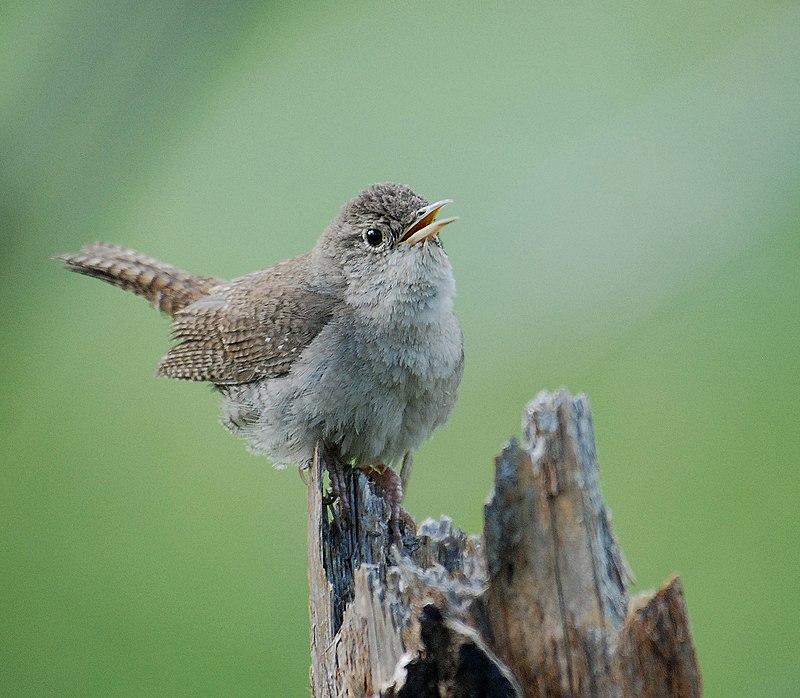
The House Wren is a small bird of the wren family found from Canada to South America. It’s quite common in suburban areas and is one of the most widely distributed native birds in North and South America.
Its taxonomy can be complicated, with some subspecies groups considered separate species.
The House Wren has a brown back, grey head, white eyebrow stripes, light chestnut belly and buffy flanks.
They often inhabit old or abandoned buildings as well as shrublands near fields or open woods for nesting sites.
During breeding season they are highly territorial so make sure you create an inviting environment if you wish to invite them into your yard.Scientific classification:
| Kingdom | Animalia |
| Phylum | Chordata |
| Class | Aves |
| Order | Passeriformes |
| Family | Troglodytidae |
| Genus | Troglodytes |
| Species | T. aedon |
2. Carolina Wren
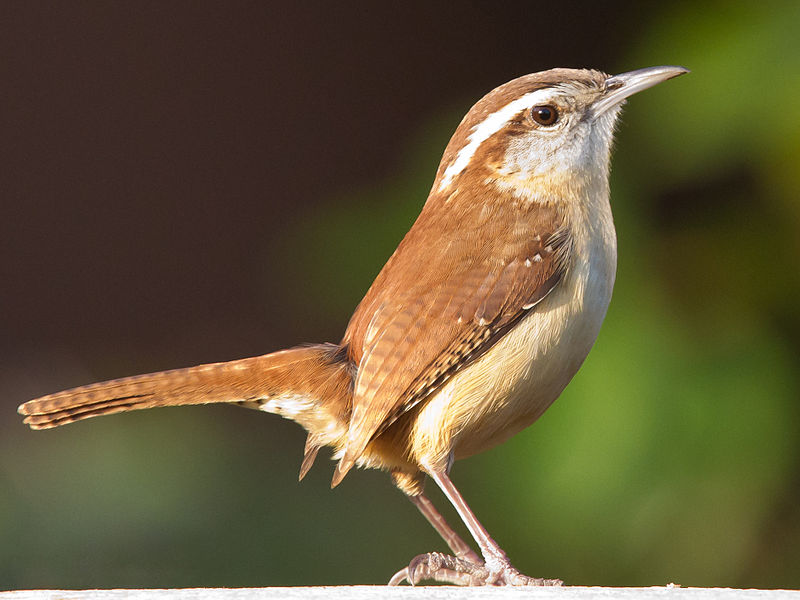
The Carolina wren (Thryothorus ludovicianus) is a medium-sized bird that can be found in the eastern United States, southern Ontario and northeast Mexico.
They typically live in dense shrubbery or thickets near open areas such as gardens, parks and woodland edges.
These birds are quite adaptable when it comes to nesting sites – they will build their nests anywhere from tree cavities to manmade boxes.
Their diet consists of insects, spiders and other invertebrates which they forage for on the ground or among vegetation.
The males have an unmistakable song made up of loud whistles interspersed with trills reminiscent of laughter; you’ll often find these cheerful little birds singing away during early morning hours.Scientific classification:
| Kingdom | Animalia |
| Phylum | Chordata |
| Class | Aves |
| Order | Passeriformes |
| Family | Troglodytidae |
| Genus | Thryothorus Vieillot, 1816[2] |
| Species | T. ludovicianus |
3. Bewick’s Wren
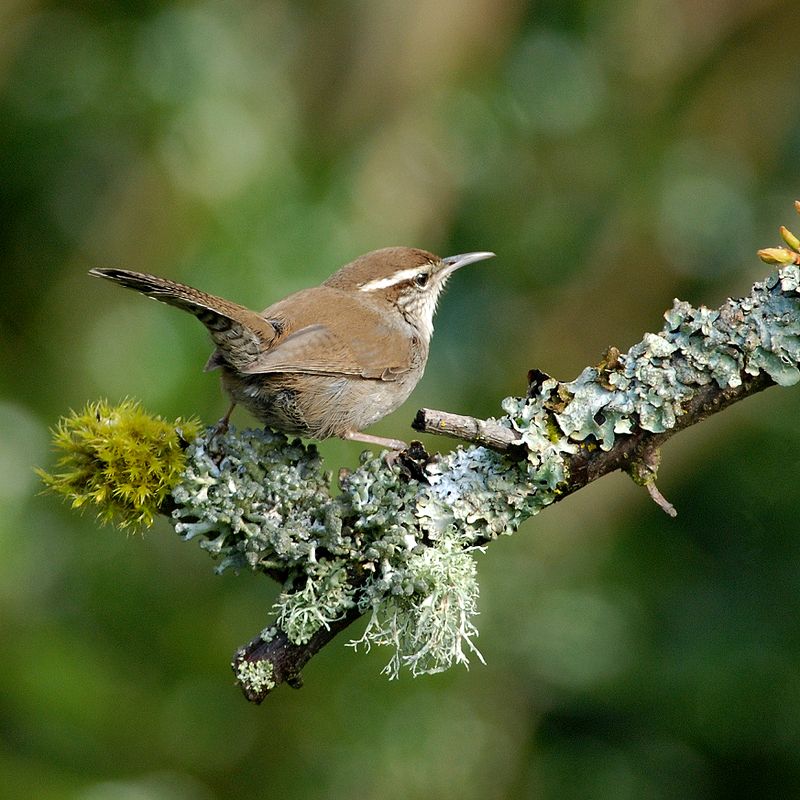
The Bewick’s wren (Thryomanes bewickii) is a small, grey-brown bird native to North America. Measuring at around 14 cm long it has distinctive white markings on its face and tail giving it an attractive appearance.
It can often be found in thickets or scrubby areas as well as urban gardens and parks.
Its song is loud and melodious which makes them popular amongst ornithologists; they are known for their complex vocalisations composed of whistles, clicks, churrs and trills.
The Bewick’s Wren mainly feeds on insects but will also eat fruits if available during the colder months when food may otherwise be scarce.
This species of wren plays an important role in controlling insect populations making them beneficial inhabitants of our environment.Scientific classification:
| Kingdom | Animalia |
| Phylum | Chordata |
| Class | Aves |
| Order | Passeriformes |
| Family | Troglodytidae |
| Genus | Thryomanes P.L. Sclater, 1862 |
| Species | T. bewickii |
4. Winter Wren
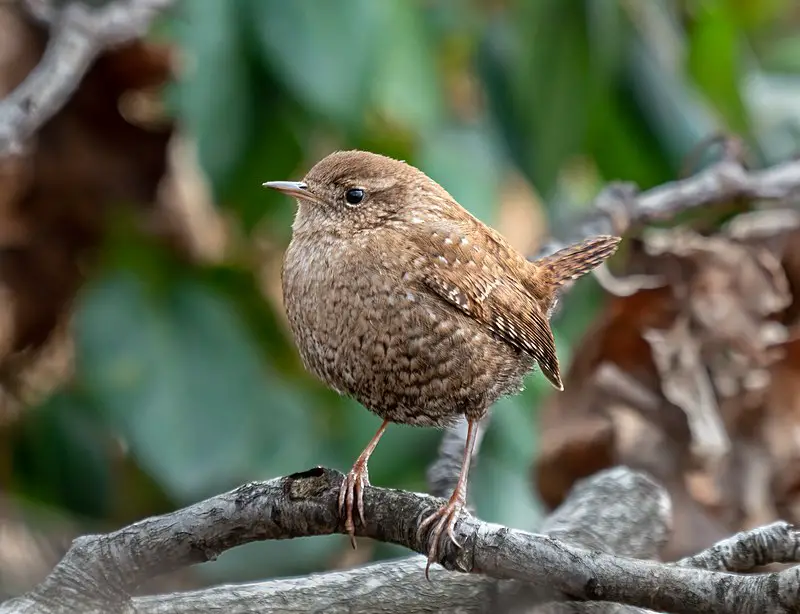
The Winter Wren is a tiny bird belonging to the New World wren family. It can be found in North America, from British Columbia all the way to the Atlantic Ocean.
In winter, it migrates south and sometimes even reaches Central America. Its habitat consists mainly of coniferous forests where it builds its nest on or near ground level within dense vegetation for protection against predators.
This small songbird has a rich brown plumage with white eyebrows and buff underparts which helps them blend into their environment perfectly.
The Winter Wrens are renowned for their loud songs that they sing both day and night during breeding season; making them an integral part of any forest ecosystem.Scientific classification:
| Kingdom | Animalia |
| Phylum | Chordata |
| Class | Aves |
| Order | Passeriformes |
| Family | Troglodytidae |
| Genus | Troglodytes |
| Species | T. hiemalis |
Also Featured In: Most Common Winter Birds, North Carolina Mountain Birds
5. Marsh Wren
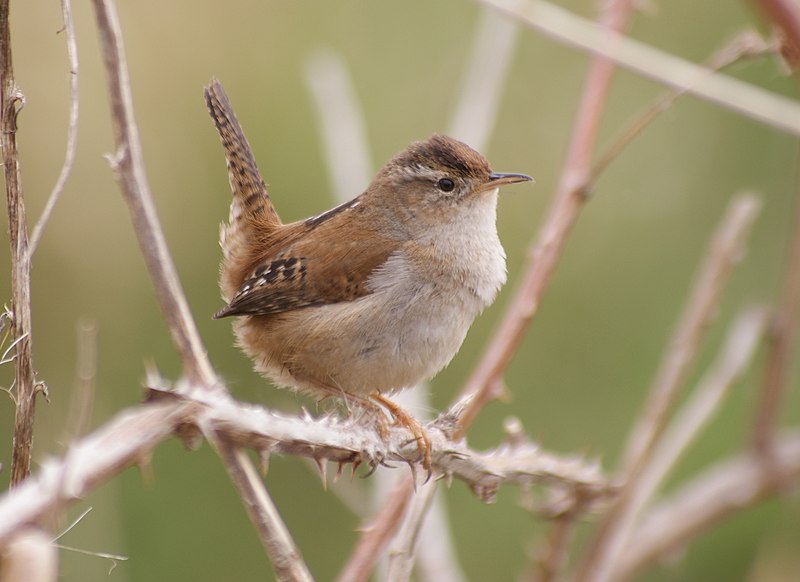
The Marsh Wren is a small bird native to North America, belonging to the wren family. It has a long bill and can be distinguished from other species of marsh birds such as the sedge wren by its size.
The Marsh Wren was first described in 1810 by Alexander Wilson under the binomial name Certhia palustris and now belongs to genus Cistothorus.
This songbird prefers wetland habitats like marshes, swamps or wetlands with dense vegetation for sheltering and nesting activities.
They build nests on grasses near water bodies which are made out of twigs attached at one end forming an enclosed cup-like structure lined with feathers or fur making it look like a woven basket.Scientific classification:
| Kingdom | Animalia |
| Phylum | Chordata |
| Class | Aves |
| Order | Passeriformes |
| Family | Troglodytidae |
| Genus | Cistothorus |
| Species | C. palustris |
Also Featured In: Most Common Songs Birds that Live around You, Wetlands Birds You Should Know
6. Eurasian Wren
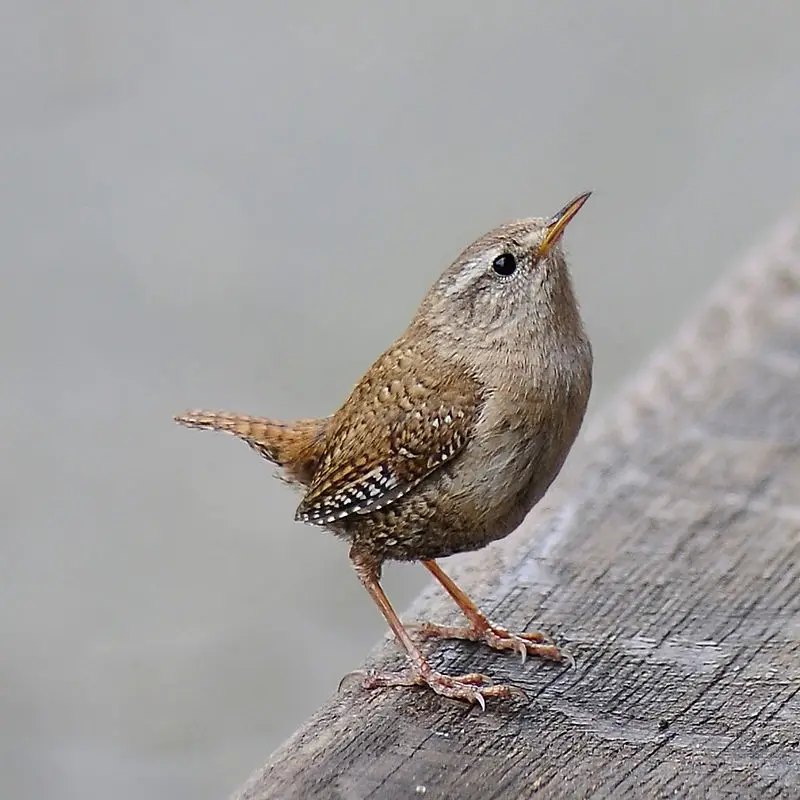
The Eurasian Wren is a small, insectivorous bird that can be found throughout Europe and Africa.
It has russet-brown upperparts with paler buff-brown underparts and its most notable feature is its short tail which it holds upright in flight or when perched.
Its neck is also quite short while the bill tends to be long and thin.
The species prefers dense vegetation like hedgerows, woodland edges and parks as well as coastal areas where there are plenty of insects for them to feed on such as spiders, beetles, caterpillars etc..
Their song consists mainly of high notes that vary between regions but usually ends with four or five repeated trills – making them an easily identifiable addition to any garden.Scientific classification:
| Kingdom | Animalia |
| Phylum | Chordata |
| Class | Aves |
| Order | Passeriformes |
| Family | Troglodytidae |
| Genus | Troglodytes |
| Species | T. troglodytes |
7. Pacific Wren
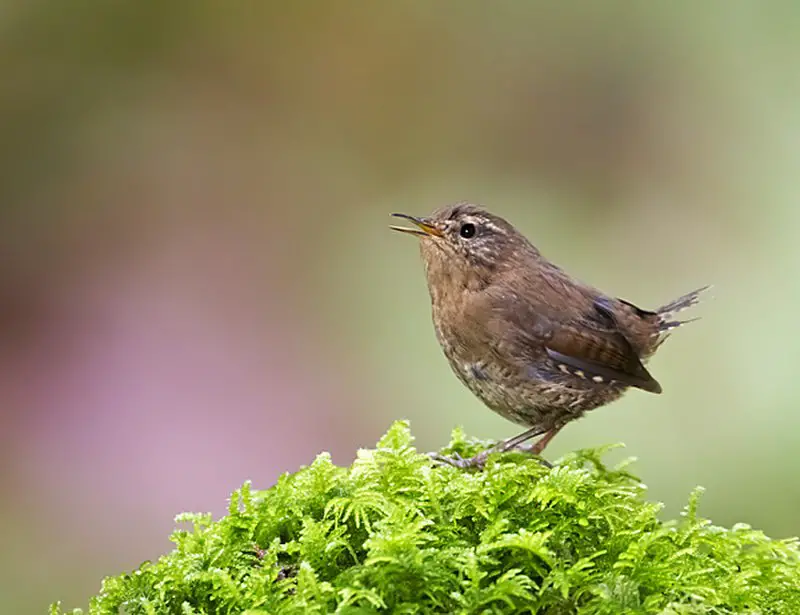
The Pacific wren is a tiny bird, belonging to the Troglodytidae family native to North America.
It breeds from Alaska down through California and inland as far as Wyoming and South Dakota in the Black Hills region.
Formerly known as ‘Winter Wren’, it has since been reclassified into its own category due to distinct characteristics such as habitat preference for forests along with being smaller than other species of wrens.
This small-bodied bird boasts beautiful brown feathers that provide camouflage against bark and twigs while they search for food like insects or spiders among debris on the forest floor.
The melodic song of this fascinating creature can often be heard echoing throughout moist coniferous regions during breeding season.Scientific classification:
| Kingdom | Animalia |
| Phylum | Chordata |
| Class | Aves |
| Order | Passeriformes |
| Family | Troglodytidae |
| Genus | Troglodytes |
| Species | T. pacificus |
8. Sedge Wren
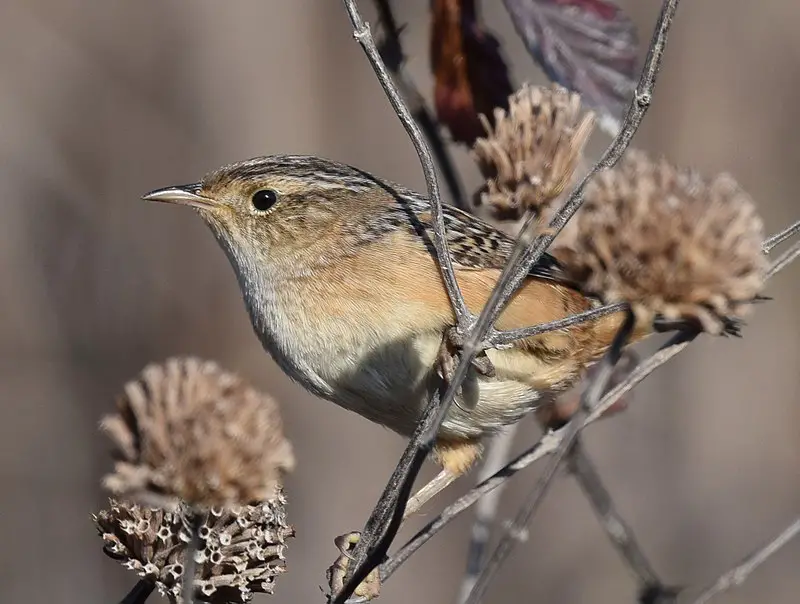
The Sedge Wren is a small, secretive bird found in North America. It prefers wet grasslands and meadows where it lives among the tall grasses and sedges, feeding on insects.
Formerly considered conspecific with the non-migratory Grass Wren of Central and South America, this species has been reclassified as its own unique species due to DNA differences between them.
However, they still share similar traits such as their brownish coloration with streaks along their back.
The Sedge Wren nests in dense vegetation which provides safety from predators while also providing plenty of food for the insectivorous birds during breeding season.
Their song consists mostly of short phrases repeated several times throughout each day making them easy to identify by sound alone.Scientific classification:
| Kingdom | Animalia |
| Phylum | Chordata |
| Class | Aves |
| Order | Passeriformes |
| Family | Troglodytidae |
| Genus | Cistothorus |
| Species | C. stellaris |
Also Featured In: Birds that Live in the Grasslands, Small Birds that Live in Michigan Birds
9. Cactus Wren
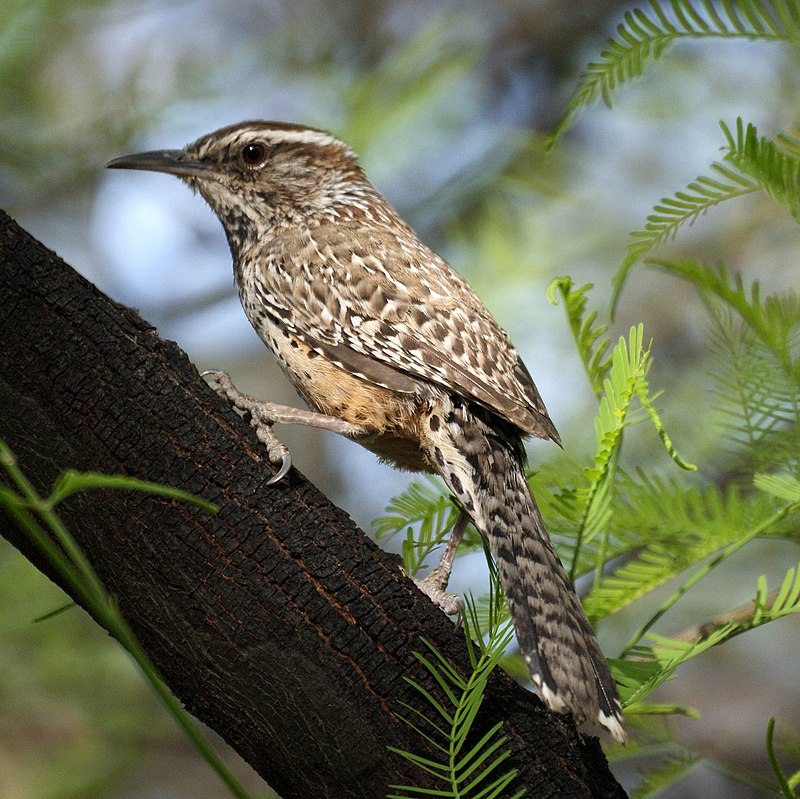
The cactus wren is an enchanting bird found in the deserts of the southwestern United States and northern and central Mexico.
It has a unique brown plumage, with black and white spots as markings, along with a distinctive white eyebrow sweeping to its nape.
Its chest is also snow-white, whereas its belly features light brown bars that contrast nicely against other feathers.
This species holds special significance for Arizona – it was declared their state bird due to its large size compared to other US wrens.
Cactus Wrens are often seen perched atop Saguaro cacti or jumping around on desert ground searching for food such as insects like beetles or spiders.Scientific classification:
| Kingdom | Animalia |
| Phylum | Chordata |
| Class | Aves |
| Order | Passeriformes |
| Family | Troglodytidae |
| Genus | Campylorhynchus |
| Species | C. brunneicapillus |
10. Canyon Wren
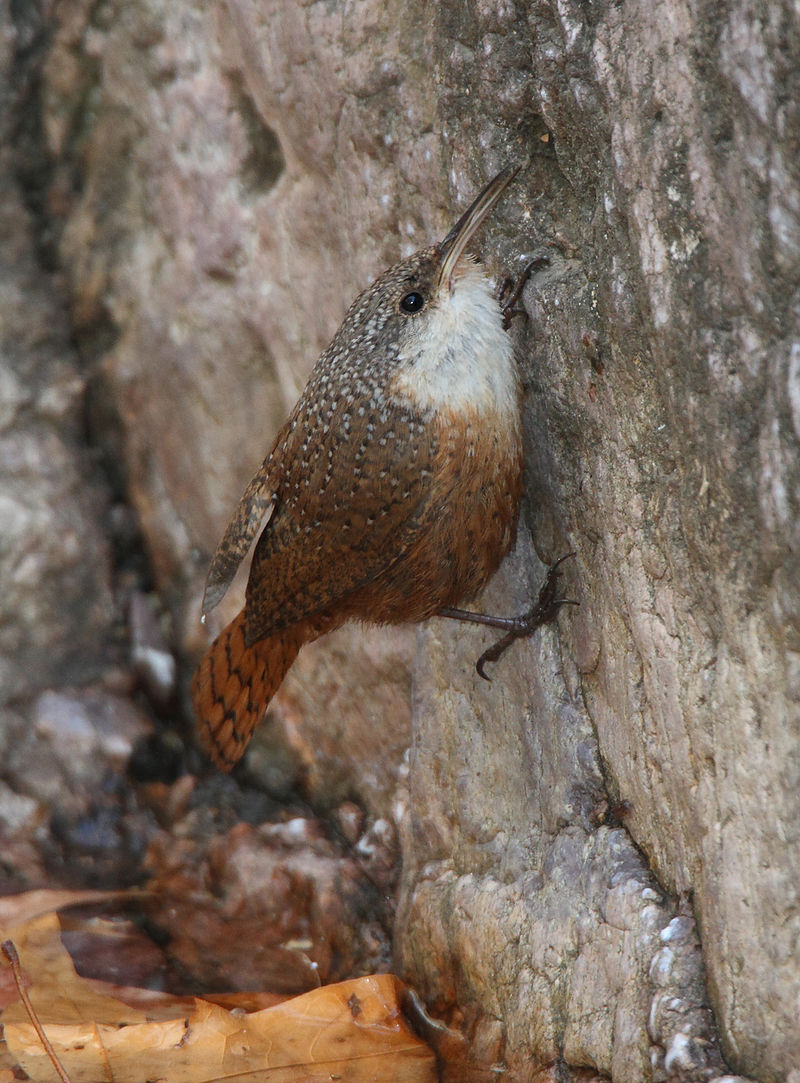
The Canyon Wren is a small songbird that belongs to the wren family, Troglodytidae. It’s native to North America and lives mainly in rocky or arid areas such as cliffs and canyons.
A distinct feature of this bird is its loud song which echoes through the canyon walls – it can be heard from far away.
The Canyon Wren has adapted well to its environment; with drab coloring helping it blend into the rocks, camouflaging itself from predators.
Its diet consists mainly of insects, spiders and snails found on cliff faces or in crevices between rocks.
As there are no other species within its taxon, they do not have any major threats aside from natural occurrences like avalanches or rock slides that could cause habitat loss for them.Scientific classification:
| Kingdom | Animalia |
| Phylum | Chordata |
| Class | Aves |
| Order | Passeriformes |
| Family | Troglodytidae |
| Genus | Catherpes Baird, 1858 |
| Species | C. mexicanus |
Also Featured In: Birds that Live in the Deserts, Birds that Live in Arizona Desert
11. Rock Wren
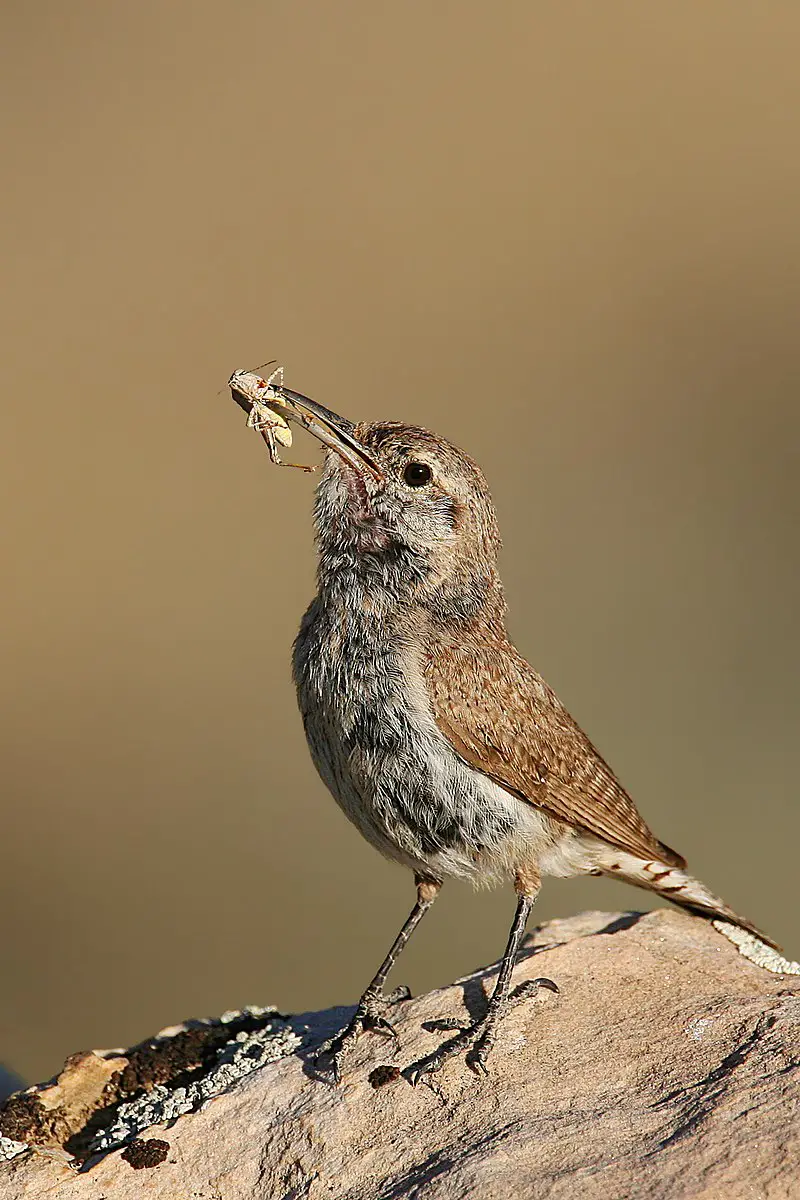
The Rock Wren is a small bird of the wren family, native to western North America, Mexico and Central America.
It features distinct grey-brown upperparts speckled with black and white spots, as well as pale grey underparts featuring a light brown rump.
This species also has an eye line that’s lightly gray in color. Additionally, it sports a long slender bill curved slightly downwards at the tip.
The wings are short but broad and rounded off with buffy or whitish colored feathers along their edges.
Its habitat includes rocky areas such as cliffsides or boulders for nesting purposes where these birds can be seen singing loud melodic songs throughout the day.Scientific classification:
| Kingdom | Animalia |
| Phylum | Chordata |
| Class | Aves |
| Order | Passeriformes |
| Family | Troglodytidae |
| Genus | Salpinctes Cabanis, 1847 |
| Species | S. obsoletus |
Also Featured In: Birds that Live in the Grand Canyon National Park, Small Kentucky Birds
12. Grass Wren
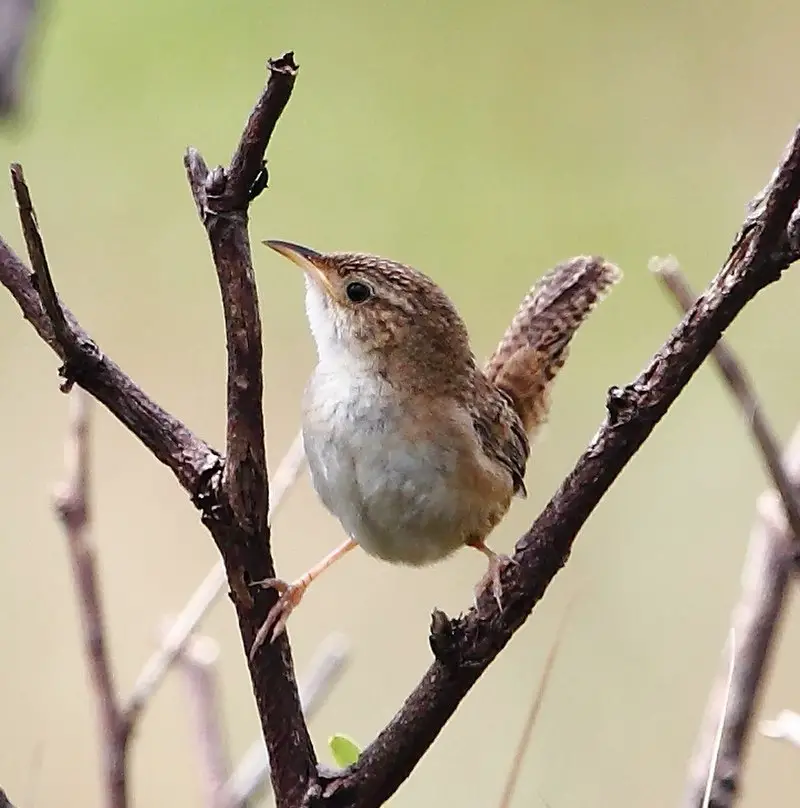
The Grass Wren is a small bird native to Central and South America. It belongs to the family Troglodytidae, which includes wrens and other songbirds.
The species was first described in 1790 by English ornithologist John Latham, who gave it its scientific name Cistothorus platensis.
They inhabit grassy habitats such as pastures, meadows or savannas where they can find their favorite food of insects and spiders.
Their plumage is mostly brownish grey with some white spots on the wings and back while their bill is short but strong enough for them to dig into soil looking for food items like tubers or seeds.
As well known ground-dwelling birds they are more often heard than seen as they search around close to the ground in thick vegetation coverings making them difficult subjects of study but also providing great joy when spotted.Scientific classification:
| Kingdom | Animalia |
| Phylum | Chordata |
| Class | Aves |
| Order | Passeriformes |
| Family | Troglodytidae |
| Genus | Cistothorus |
| Species | C. platensis |
Also Featured In: Falkland Islands Birds You Need To Know,
13. Superb Fairywren
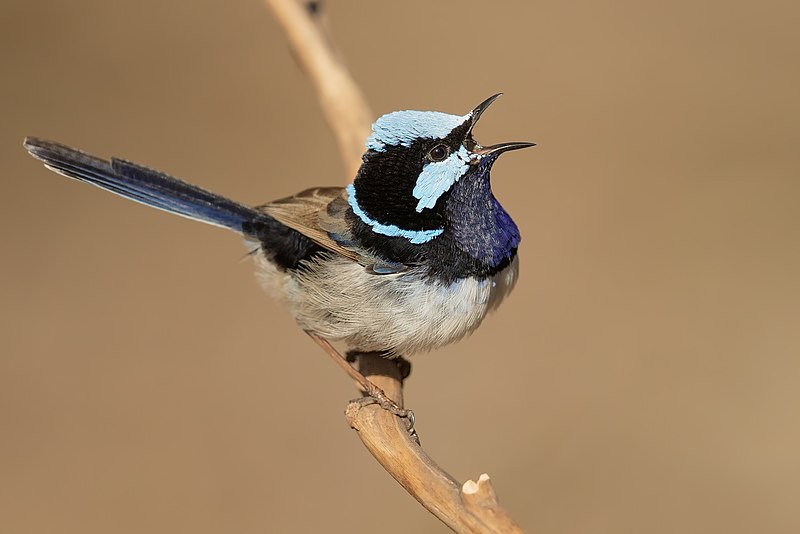
The Superb Fairywren is a beautiful and unique bird native to southeastern Australia.
The male in breeding plumage has an impressive bright blue forehead, ear coverts, mantle and tail with a black mask and either black or dark blue throat.
They are sedentary birds that form strong territorial bonds with their mates; the males staying close-by while the females build nests away from them.
These birds exhibit high sexual dimorphism; making it easy for us to distinguish between males and females of this species.
Their diet consists primarily of insects although they will also feed on other invertebrates as well as nectar, fruit and seeds when available.
This small passerine bird is sure to bring any garden alive with its vibrant colours.Scientific classification:
| Kingdom | Animalia |
| Phylum | Chordata |
| Class | Aves |
| Order | Passeriformes |
| Family | Maluridae |
| Genus | Malurus |
| Species | M. cyaneus |
14. Mountain Wren
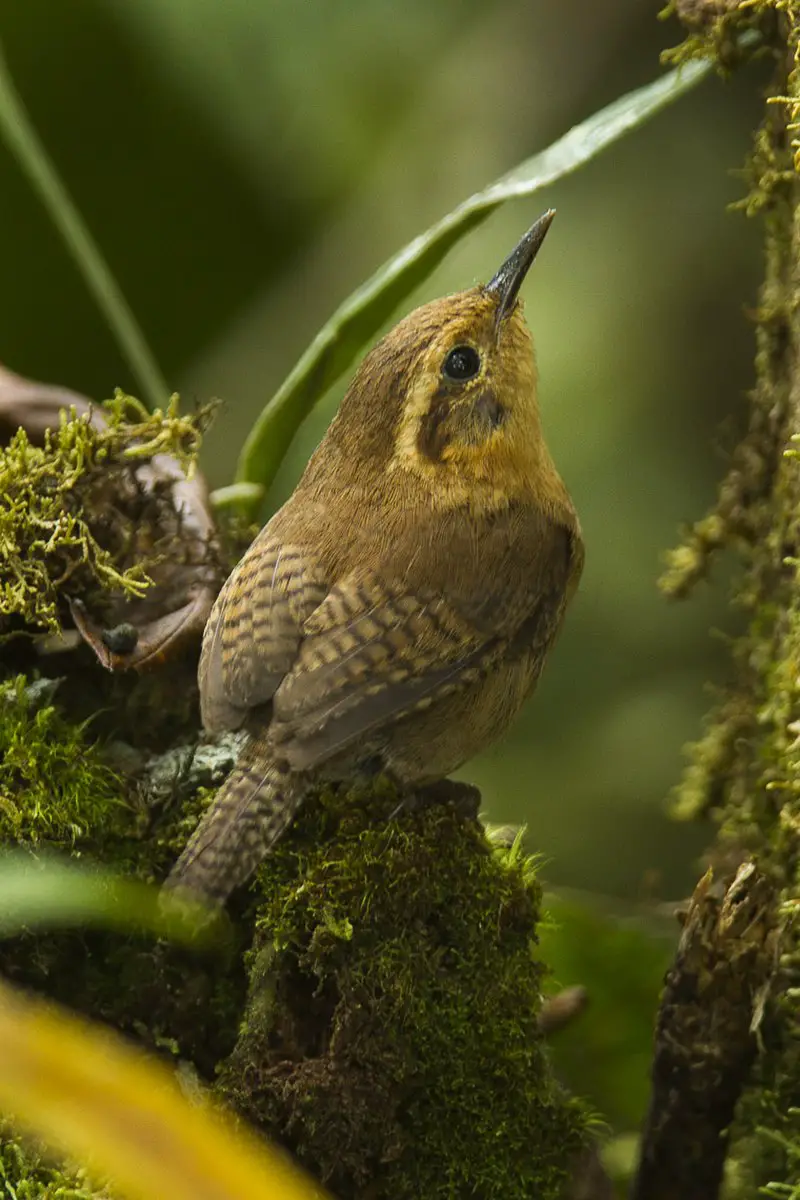
The Mountain Wren, a species of bird belonging to the Troglodytidae family, can be found in the Andes mountains across South America.
This small songbird has an impressive range that encompasses northwestern Argentina, Bolivia, Colombia Ecuador Peru and western Venezuela.
It is characterised by its grey-brown plumage with white speckles on its face and throat area.
The male also features distinctive black stripes along his back which are absent from the female’s more muted brown colouring pattern.
These birds typically inhabit rocky outcrops or areas filled with dense vegetation where they forage for insects among leaf litter and undergrowth.
With their melodious trilling songs during mating season these little feathered friends make up part of the delightful soundscape around them.Scientific classification:
| Kingdom | Animalia |
| Phylum | Chordata |
| Class | Aves |
| Order | Passeriformes |
| Family | Troglodytidae |
| Genus | Troglodytes |
| Species | T. solstitialis |
15. Giant Wren
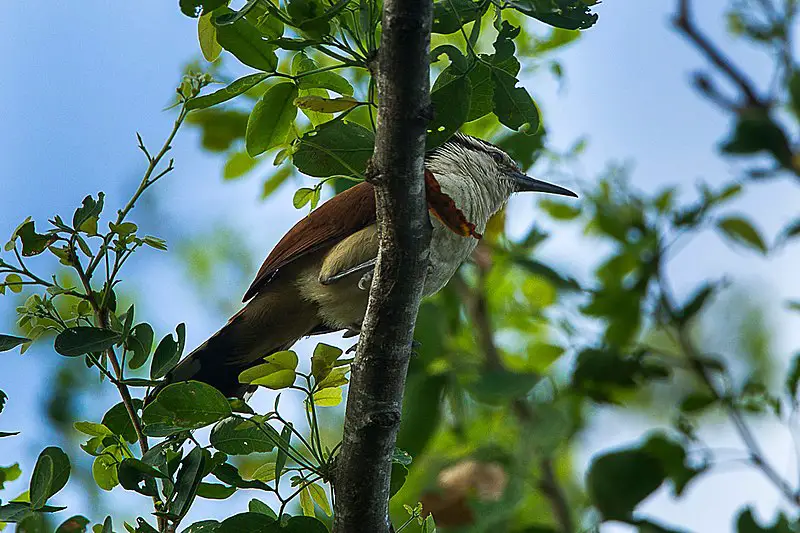
The Giant Wren is a species of bird found in Mexico and Guatemala, belonging to the family Troglodytidae. It is monotypic, meaning there are no distinct subspecies that exist within its range.
Generally speaking birds from the northern parts tend to be larger however this difference isn’t enough for them to be considered separate subspecies.
In some cases it has been treated as a subspecies of Bicolored Wren (Campylorhynchus griseus) and may form part of a superspecies with other wrens like Cinnycerthia olivascens and Thryothorus sinaloa among others.
The Giant Wren can typically reach sizes between 16-18cm long making it one of the largest members in its family when compared against related species such as House or Winter wrens which max out at about 14 cm in length respectively.Scientific classification:
| Kingdom | Animalia |
| Phylum | Chordata |
| Class | Aves |
| Order | Passeriformes |
| Family | Troglodytidae |
| Genus | Campylorhynchus |
| Species | C. chiapensis |
16. Grey Wren
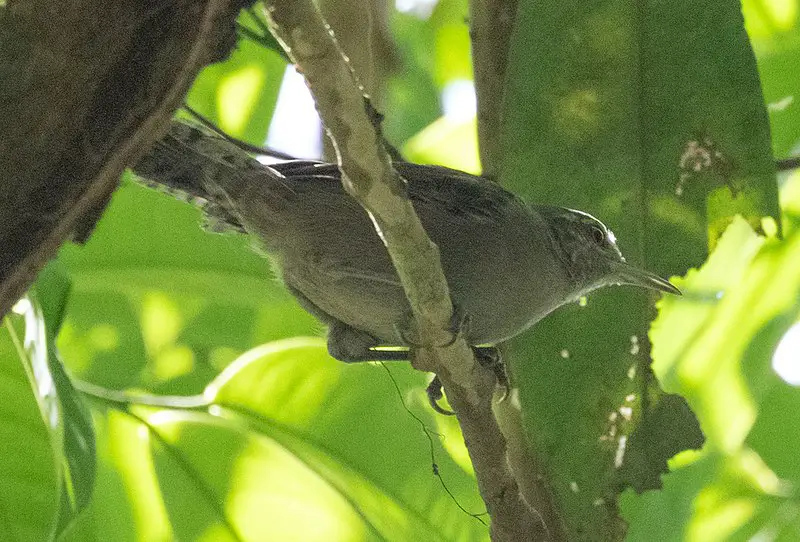
The Grey Wren is a small bird that belongs to the Troglodytidae family and is found only in the southwestern part of Brazil’s Amazonas state. It has grey upperparts, which make it look similar to House Wrens.
This species was formerly placed under Thryothorus genus but later moved out due to its paraphyletic nature.
The Grey Wren measures about 12–13 cm long with a wingspan between 16-17cm and weighs around 10 grams on average.
Its diet consists mostly of insects such as beetles, grasshoppers, caterpillars etc., along with some seeds and fruits if available.
Despite being poorly known yet, this species holds an important place in ecology since they help control insect populations by predating them for food sourcesScientific classification:
| Kingdom | Animalia |
| Phylum | Chordata |
| Class | Aves |
| Order | Passeriformes |
| Family | Troglodytidae |
| Genus | Cantorchilus |
| Species | C. griseus |
17. Clarión Wren
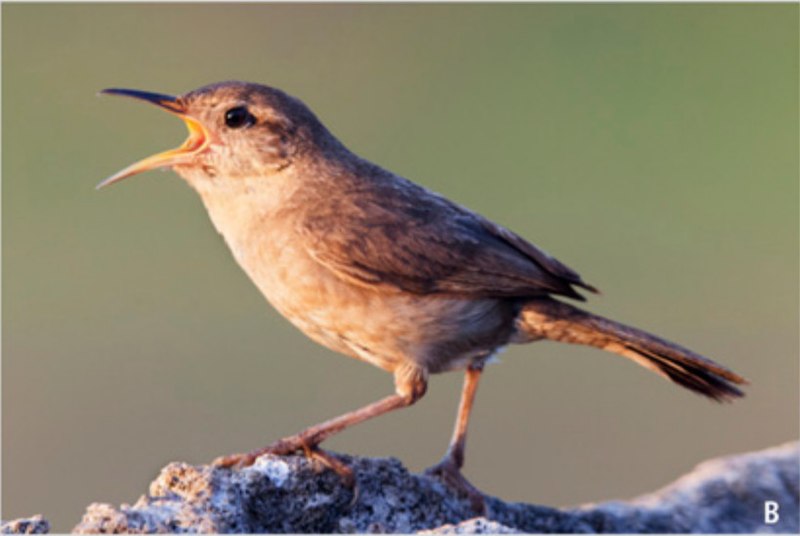
The Clarión wren is a species of bird found in the family Troglodytidae. Endemic to Mexico’s Pacific coast, it can be seen on Clarión Island.
It resembles a house wren but has an elongated bill like that of Carolina wrens and is larger too.
Its habitat consists of shrubland with thickets of Ipomoea halierca morning glory, which provide ample cover for its feathers while they hunt or roost.
The Clarión Wren feeds mostly on insects such as spiders and beetles, along with small fruits when available.
While not threatened at present, their numbers remain low due to limited access to suitable habitats so conservation efforts are important for them survive long into the future.Scientific classification:
| Kingdom | Animalia |
| Phylum | Chordata |
| Class | Aves |
| Order | Passeriformes |
| Family | Troglodytidae |
| Genus | Troglodytes |
| Species | T. tanneri |
18. Fasciated Wren
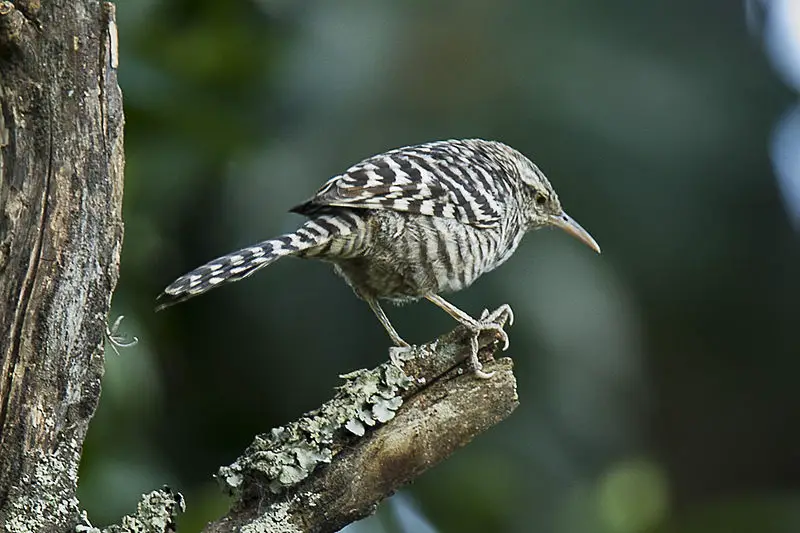
The Fasciated Wren is a species of bird belonging to the Troglodytidae family, native to Peru and Ecuador. It has two subspecies: Campylorhynchus fasciatus fasciatus and C.f pallescens.
The wren is about 19 cm (7.5 inches) long with females weighing 24.9 g (0.88 oz).
Both sexes have gray crowns on their head with grayish-brown backs, tail feathers tipped in white, chestnut throats, yellow breasts spotted black along its sides as well as white belly areas that extends from below its throat down to bottom part of breast area while males having slightly darker upperparts than females’.
Despite being small sized birds they are quite loud and active during daytime boasting distinctive voices which helps recognize one another amidst dense vegetation where it typically inhabits.Scientific classification:
| Kingdom | Animalia |
| Phylum | Chordata |
| Class | Aves |
| Order | Passeriformes |
| Family | Troglodytidae |
| Genus | Campylorhynchus |
| Species | C. fasciatus |
19. Boucard’s Wren
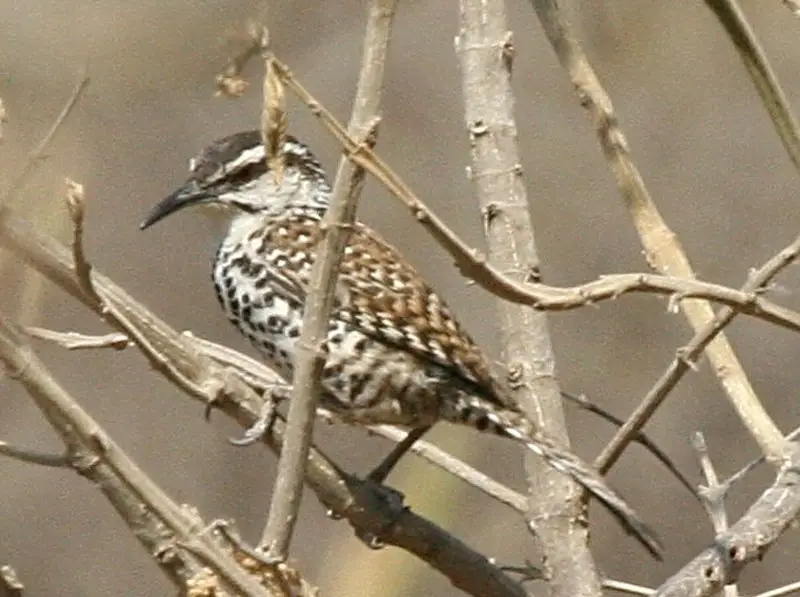
Boucard’s wren is an endemic bird species found only in Mexico. It belongs to the family Troglodytidae and has no subspecies. This small, sprightly bird measures 17 cm (6.7 in) long and weighs 23.8 to 29.8 g (0.84 – 1.05 oz).
Its upperparts are grayish-brown while its underparts are barred with white, brown or black streaks depending on the region where it is found; they also possess a distinctive pale yellow supercilium which extends from their bill up to the back of their neck .
Boucard’s Wrens mostly feed on insects but can also be seen foraging for seeds at times as well.
They often make short trilling calls during flight, adding songful music to our natural environment.Scientific classification:
| Kingdom | Animalia |
| Phylum | Chordata |
| Class | Aves |
| Order | Passeriformes |
| Family | Troglodytidae |
| Genus | Campylorhynchus |
| Species | C. jocosus |
20. Splendid Fairywren
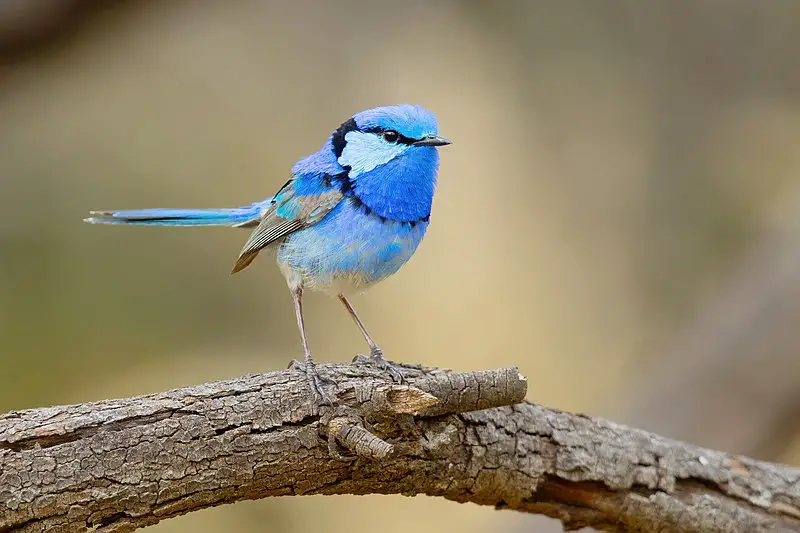
The Splendid Fairywren is a beautiful little passerine bird belonging to the Maluridae family. It can be found across much of Australia, from central-western New South Wales and southwestern Queensland over to coastal Western Australia.
This small wren resides in different pre-forested areas including woodlands, heaths and shrubbery as well as urban gardens; they often form lifetime pair bonds with each other during breeding season.
The male has an impressive display plumage that consists of bright blue on its wings, tail and rump while the female’s feathers are more brownish gray in color.
They feed mainly on insects but also eat nectar for sustenance when available. The Splendid Fairywren is quite common throughout its range thanks to their adaptability which allows them to thrive even near humans.Scientific classification:
| Kingdom | Animalia |
| Phylum | Chordata |
| Class | Aves |
| Order | Passeriformes |
| Family | Maluridae |
| Genus | Malurus |
| Species | M. splendens |
21. Veracruz Wren
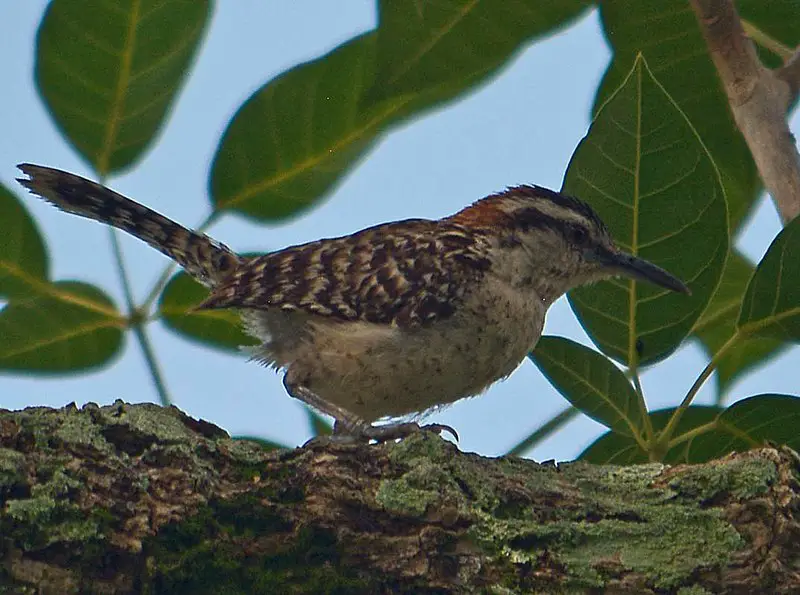
The Veracruz wren is a songbird belonging to the family Troglodytidae, endemic to Mexico. It was previously classified as one of eight subspecies under the binomial Campylorhynchus rufinucha but after further research it has been recognized as its own species in 2009.
This small bird is typically grey-brown with white streaks and a reddish nape across its back.
Its tail feathers have black barring on top and whitish tips beneath them; they are longer than other species within this group which helps distinguish it from similar birds like Rufous-naped Wrens or Sinaloan Wrens.
The diet of these birds consists mainly of insects such as grasshoppers, beetles, caterpillars etc., however some fruit may also be consumed seasonally when available.Scientific classification:
| Kingdom | Animalia |
| Phylum | Chordata |
| Class | Aves |
| Order | Passeriformes |
| Family | Troglodytidae |
| Genus | Campylorhynchus |
| Species | C. rufinucha |
22. Bicolored Wren
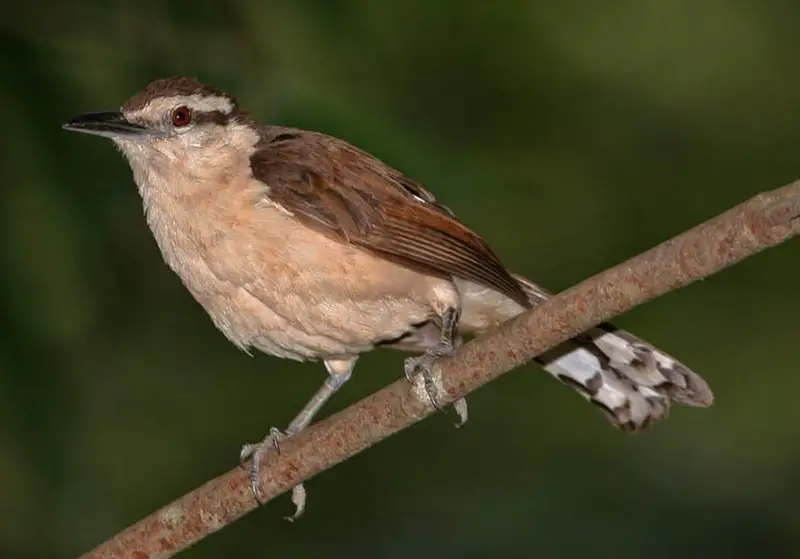
The Bicolored Wren is a species of bird belonging to the family Troglodytidae. It can be found in Colombia, Venezuela, Guyana and Brazil.
This small bird has six subspecies and sometimes is grouped with the Giant Wren forming what could be considered as a superspecies between them both.
The most common characteristics among all its subspecies are predominately grey-brown plumage above, white underparts streaked with brown or black markings; dark cheek patch bordered by narrow white line; yellow bill and legs; pale eyebrows on adults and juveniles respectively buffish or whitish crowns.
Its diet consists mainly of insects that it hunts while foraging through low vegetation during early morning hours where they search for food usually in pairs but also may form larger flocks near fruiting trees when available.Scientific classification:
| Kingdom | Animalia |
| Phylum | Chordata |
| Class | Aves |
| Order | Passeriformes |
| Family | Troglodytidae |
| Genus | Campylorhynchus |
| Species | C. griseus |
23. Song Wren
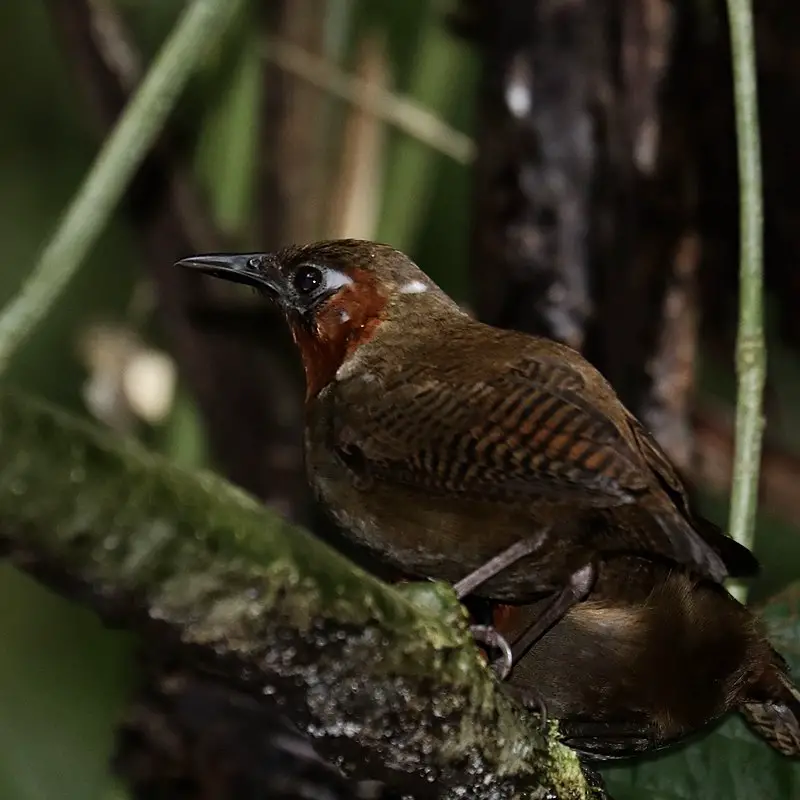
The Song Wren (Cyphorhinus phaeocephalus) is a species of bird found in Central and South America.
This small, brown-plumaged songbird belongs to the family Troglodytidae, which includes wrens and other related birds like kinglets.
Its range stretches from Colombia to Panama, where it can be seen in forested areas as well as open woodlands.
The Song Wren was once believed to be closely related to the Musician Wren (Cypohinus arada), with both species being part of one superspecies – however recent studies have suggested that this may not necessarily be true.
These tiny birds are highly territorial during breeding season and males sing loudly throughout their area as they try attract mates.Scientific classification:
| Kingdom | Animalia |
| Phylum | Chordata |
| Class | Aves |
| Order | Passeriformes |
| Family | Troglodytidae |
| Genus | Cyphorhinus |
| Species | C. phaeocephalus |
24. White-Winged Fairywren
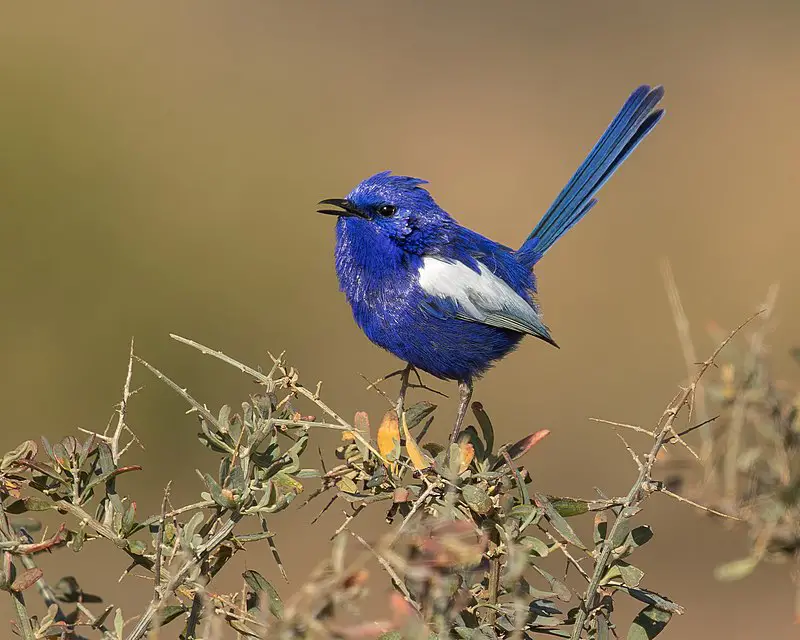
The White-winged Fairywren is a species of passerine bird from the Australasian wren family. It inhabits Central Australia, ranging from South Australia to Queensland and Western Australia, in drier regions.
Males are known for their brightly coloured plumage during breeding season while females display dull feathers year round.
This sexual dimorphism helps males attract mates more easily and provides insight into the species’ social structures: one or more males will dominate a group with bright colours as signs of dominance over other members within it.
The diet consists mainly of small insects such as ants, spiders and grasshoppers supplemented by seeds when available.
They often feed in pairs or larger groups which can help spot predators better than when alone; they also perch atop shrubs to look out for any potential dangers quickly before returning back to ground level to resume feeding once again.Scientific classification:
| Kingdom | Animalia |
| Phylum | Chordata |
| Class | Aves |
| Order | Passeriformes |
| Family | Maluridae |
| Genus | Malurus |
| Species | M. leucopterus |
Also Featured In: Birds that Live Near Adelaide,
25. Wing-Banded Wren
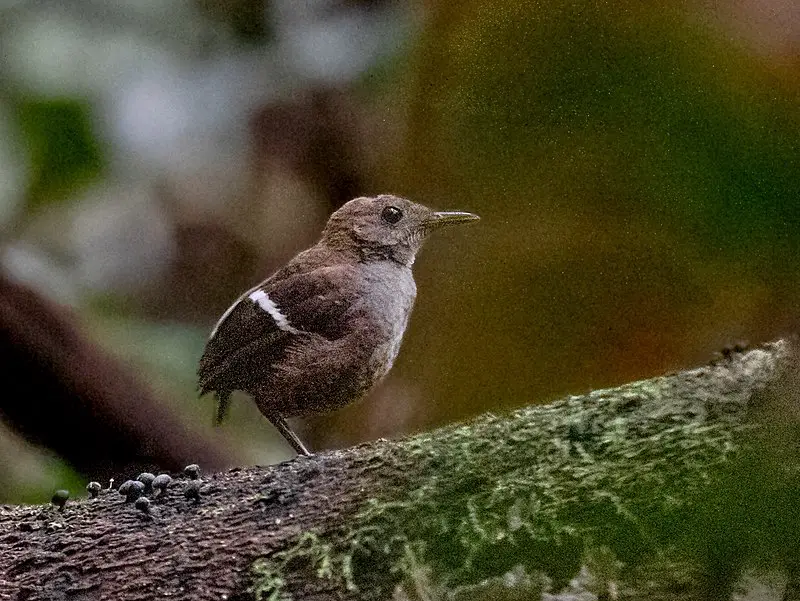
The Wing-banded Wren is a species of bird belonging to the Troglodytidae family. It has a wide range, spanning from Brazil all the way up to Venezuela and Ecuador in South America.
This small brownish-grey wren was first described by French polymath Georges-Louis Leclerc in 1779 after being spotted in Cayenne, French Guiana.
Its features include its broad white supercilium as well as black streaks on each side of its face which also form an ‘X’ shape across its back with two white bands extending towards each wing tip – hence giving it its name: Wing-banded Wren.
While little else is known about this peculiar species due to lack of research, it can be found living mainly within lowland forests below 1400m altitude where they forage for insects amongst foliage or along tree trunks near water bodies such as streams or rivers.Scientific classification:
| Kingdom | Animalia |
| Phylum | Chordata |
| Class | Aves |
| Order | Passeriformes |
| Family | Troglodytidae |
| Genus | Microcerculus |
| Species | M. bambla |
26. Southern Nightingale-Wren
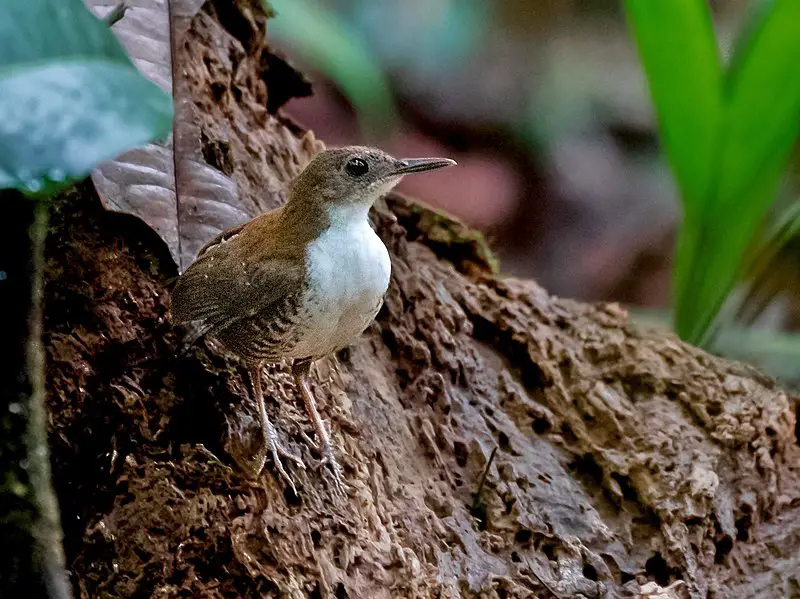
The Southern Nightingale-Wren is a species of bird in the family Troglodytidae found across South America, from Bolivia to Venezuela. It forms part of an interesting species pair with its northern counterpart, the Northern Nightingale-Wren.
Both birds have a similar appearance but can be recognized by their distinct calls and ranges; while one inhabits southern regions, the other lives mainly in Central America and Mexico.
They are small songbirds that measure around 10 cm long – they have grayish brown heads with dark stripes running across them as well as scaly markings on their breasts which give them their name.
The male has two white wingbars contrasting against his darker plumage making him easily identifiable when seen during flight or perched atop trees singing his sweet melodies throughout springtime.Scientific classification:
| Kingdom | Animalia |
| Phylum | Chordata |
| Class | Aves |
| Order | Passeriformes |
| Family | Troglodytidae |
| Genus | Microcerculus |
| Species | M. marginatus |
27. Stripe-Backed Wren
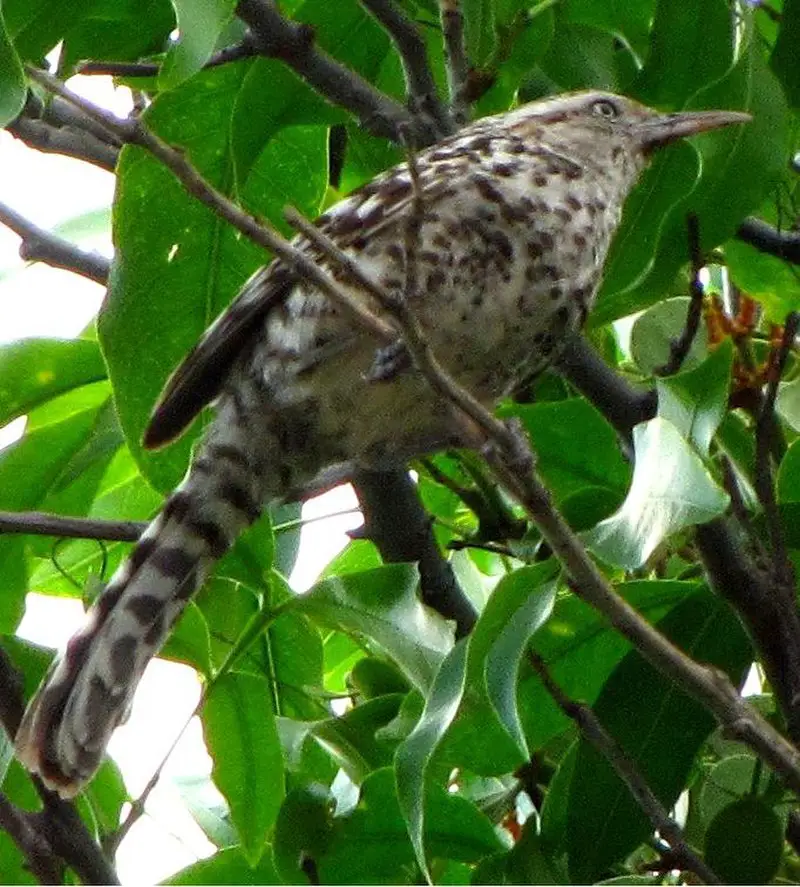
The Stripe-backed Wren is a fascinating bird found in dry, riparian woodlands or farmlands of northern Colombia and central Venezuela. It lives at heights up to 800 m and can be recognized by its yellowish stripe across the back.
This species has attracted considerable scientific interest because it is an example of cooperative breeding: groups consisting of 2 to 10 adults live together with one dominant pair leading the group while others help out with nest building, incubation and feeding offspring.
The Stripe-backed Wrens typically feed on insects, small fruit and berries but their diet may vary depending on seasonality.
They have loud calls which serve as both alarm signals for potential predators as well as territorial warnings against other birds encroaching onto their living space.Scientific classification:
| Kingdom | Animalia |
| Phylum | Chordata |
| Class | Aves |
| Order | Passeriformes |
| Family | Troglodytidae |
| Genus | Campylorhynchus |
| Species | C. nuchalis |
28. Purple-Crowned Fairywren
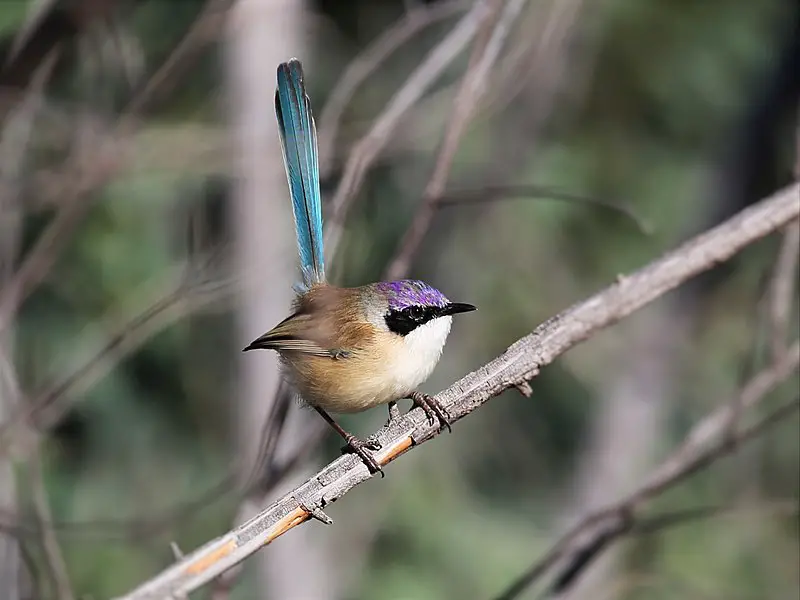
The Purple-crowned fairywren is a species of bird belonging to the Australasian wren family, Maluridae. It is endemic to northern Australia and stands out due its large size compared to other members of its genus.
Breeding males have an impressive purple circle of crown feathers which gave rise to their scientific name “coronatus”, meaning crowned in Latin.
Recent genetic evidence has shown that this species consists on two distinct populations: one residing in Eastern Australia near Queensland and another further west around Northern Territory’s coastlines.
They feed mainly on insects but can also be seen feasting on fruits or seeds found among shrubs or bushes during dry seasons when food sources are scarce.
This beautiful Australian native will surely captivate you with its stunning plumage.Scientific classification:
| Kingdom | Animalia |
| Phylum | Chordata |
| Class | Aves |
| Order | Passeriformes |
| Family | Maluridae |
| Genus | Malurus |
| Species | M. coronatus |
Also Featured In: Magenta Birds You Didn’t Know,
29. Golden-Crowned Kinglet
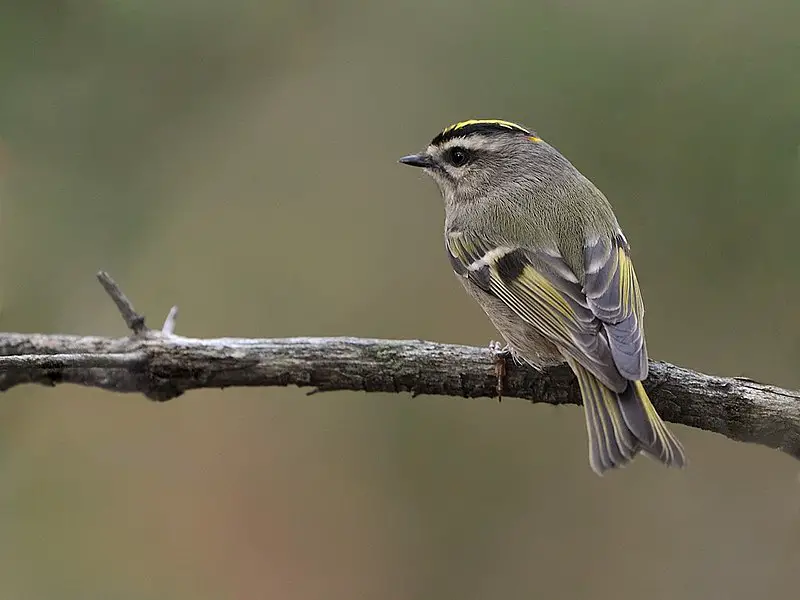
The Golden-crowned Kinglet is a small songbird native to North America. It has an olive-gray top and white underparts, with thin bills and short tails.
The most distinguishing feature of this bird is its yellow crown, surrounded by a black patch that extends through the eyes.
Males have an additional orange patch in the middle of their yellow crowns. They are active birds, often seen flitting from branch to branch as they search for insects or other food sources in trees or shrubs.
During winter months when there’s less insect prey available, Golden-crowned Kinglets will join mixed species flocks searching for berries on bushes and trees throughout forests across North America.Scientific classification:
| Kingdom | Animalia |
| Phylum | Chordata |
| Class | Aves |
| Order | Passeriformes |
| Family | Regulidae |
| Genus | Regulus |
| Species | R. satrapa |
Also Featured In: Birds that Live in Vancouver, Birds in Pacific Northwest
30. Stripe-Breasted Wren
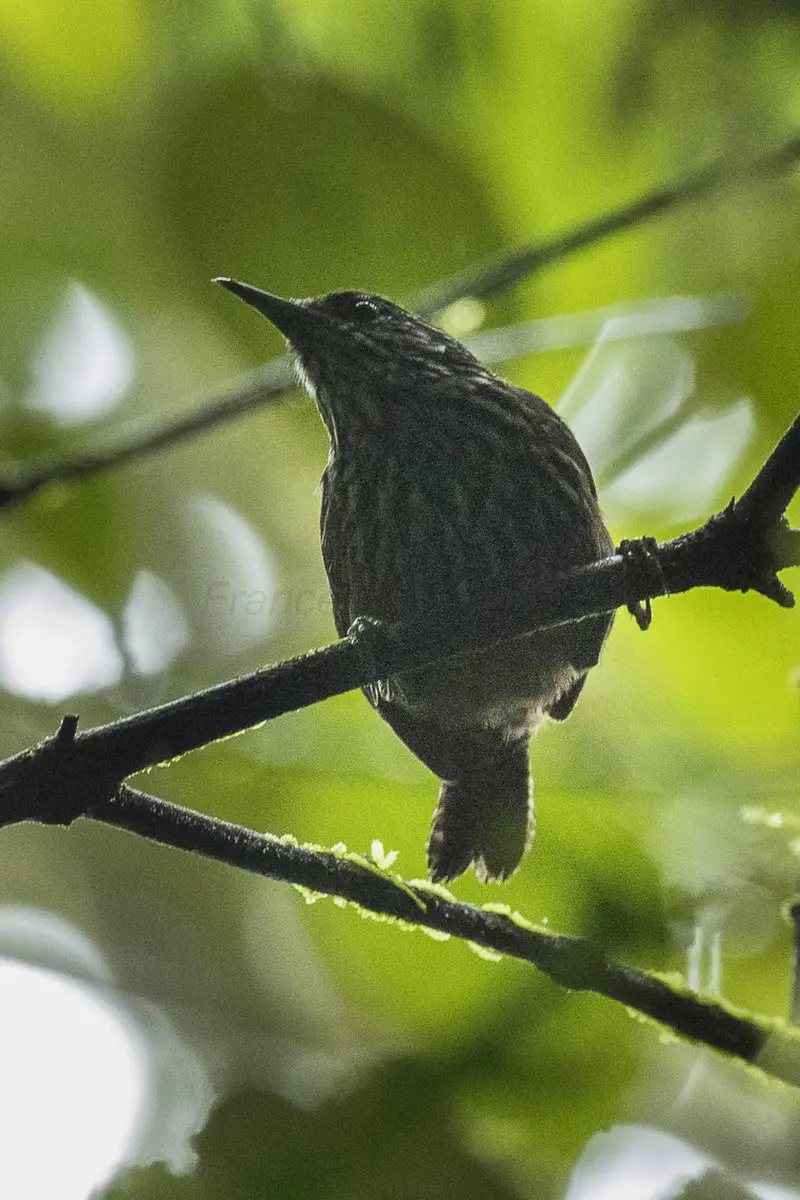
The Stripe-breasted Wren is a species of bird in the family Troglodytidae and can be found in Honduras, Nicaragua, Costa Rica, and Panama.
It has been considered to form a superspecies with the stripe-throated wren due to its close resemblance.
This small bird measures between 11.5 cm – 12.5 cm (4.5 inches – 4.9 inches). Its plumage consists mainly of greyish brown feathers on its head, wings and tail while it sports black striping along its breast region which gives it its distinctive name ‘stripe-breasted’ wren.
Interestingly enough this little creature also has an unusually large bill for such a small size making them more unique than most birds out there.Scientific classification:
| Kingdom | Animalia |
| Phylum | Chordata |
| Class | Aves |
| Order | Passeriformes |
| Family | Troglodytidae |
| Genus | Cantorchilus |
| Species | C. thoracicus |
31. Band-Backed Wren
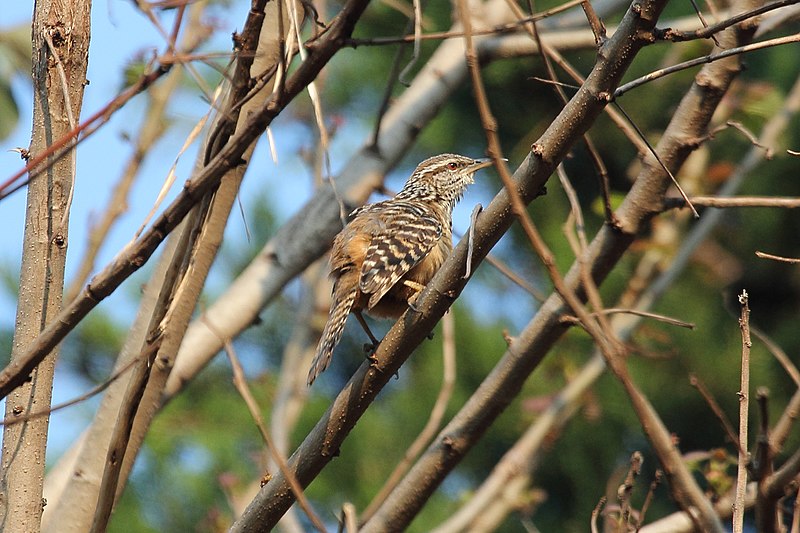
The Band-backed Wren is a small songbird of the wren family, found in five disjunct areas from south-central Gulf Coast Mexico to northwestern Ecuador.
This species is a resident breeding bird that typically inhabits tropical forests and woodlands near rivers.
It has two black stripes on its back, the namesake “band,” separating brown dorsal plumage with white spots along its sides; their chest color can vary from greyish to buffy yellow depending on location.
Its diet consists mostly of insects and other invertebrates, as well as some fruits when available.
The male usually sings during dawn and dusk hours while perched atop branches or vines in order to attract mates for reproduction purposes which typically occurs between August – March throughout Central America and South America.Scientific classification:
| Kingdom | Animalia |
| Phylum | Chordata |
| Class | Aves |
| Order | Passeriformes |
| Family | Troglodytidae |
| Genus | Campylorhynchus |
| Species | C. zonatus |
32. Ochraceous Wren
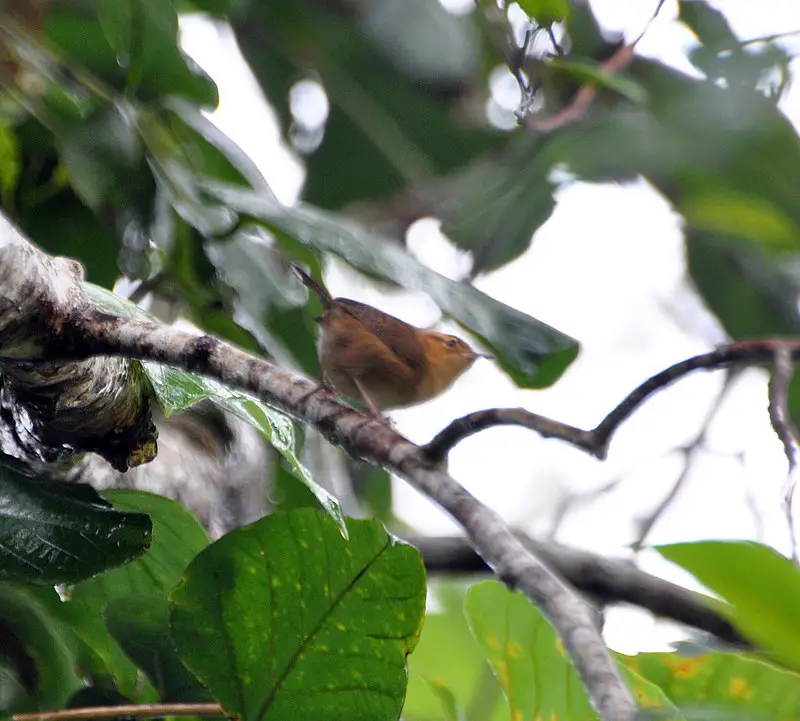
The Ochraceous Wren is a small bird belonging to the wren family, with its habitat covering Costa Rica, Panama and Colombia.
It was previously considered as a subspecies of mountain wren until it was recognized by International Ornithological Committee (IOC).
The two subspecies are named after the nominate Troglodytes ochraceus ochraceus.
This species has an overall brownish-orange coloration that makes them stand out in their environment; they have white bellies and streaked breasts with black stripes which give them more character.
They feed on insects such as beetles, caterpillars or grasshoppers and also consume fruits when available.
These birds live mainly in the forest from sea level up to 2200 meters above ground where there’s vegetation cover for protection against predators like hawks or other large raptors.
As all wrens do, this species sings beautiful songs to attract mates during breeding season when pairs form monogamous bonds that can last several years.Scientific classification:
| Kingdom | Animalia |
| Phylum | Chordata |
| Class | Aves |
| Order | Passeriformes |
| Family | Troglodytidae |
| Genus | Troglodytes |
| Species | T. ochraceus |
33. Wrentit
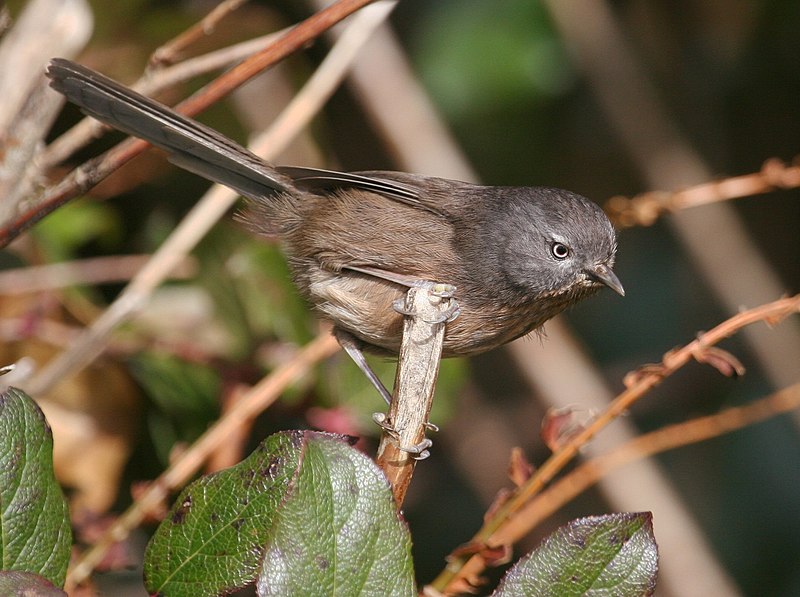
The Wrentit (Chamaea fasciata) is a small bird native to the western coast of North America, living in chaparral and oak woodlands.
It has been studied by scientists for many years due to its unique systematics; it is the only species within its genus Chamaea.
Its name reflects this uncertain classification as “wren” was originally used generically for any unknown or misidentified little brown birds.
The Wrentit typically measures between four and five inches long with grayish-brown upperparts that are streaked white on their wings and tail feathers, while their breast plumage is yellowish-buff color with black streaks running across them.
They have an affinity for dense thickets where they can search through fallen leaves looking for insects.Scientific classification:
| Kingdom | Animalia |
| Phylum | Chordata |
| Class | Aves |
| Order | Passeriformes |
| Family | Paradoxornithidae |
| Genus | Chamaea Gambel, 1847 |
| Species | C. fasciata |
34. Spotted Wren
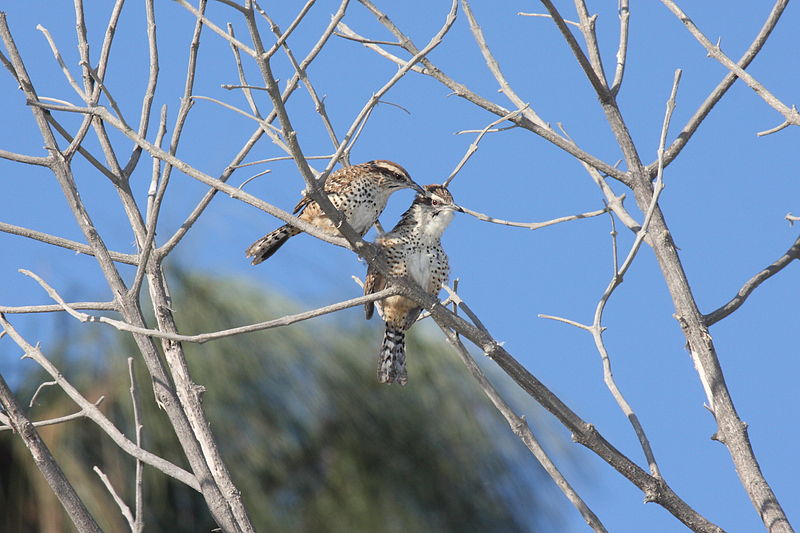
The Spotted Wren (Campylorhynchus gularis) is a species of bird native to Mexico. It’s typically around 17 cm in length and weighs between 28-31 grams, making it one of the smaller members of the Troglodytidae family.
It has sometimes been confused with Boucard’s wren due to similarities in their appearance but molecular data confirms that they are actually not closely related.
This species is monotypic meaning there aren’t any subspecies or varieties within its group; all spotted wrens look identical.
They have a brown back, white wings, black tail feathers and chestnut streaks on their flanks – giving them an attractive speckled pattern overall.Scientific classification:
| Kingdom | Animalia |
| Phylum | Chordata |
| Class | Aves |
| Order | Passeriformes |
| Family | Troglodytidae |
| Genus | Campylorhynchus |
| Species | C. gularis |
Also Featured In: Most Common Birds in Michoacán,
35. Cobb’s Wren
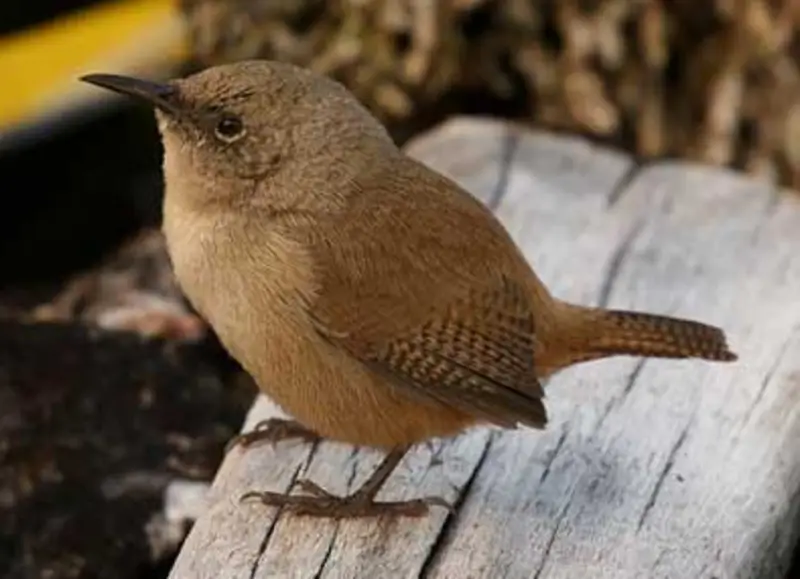
Cobb’s wren is a small bird endemic to the Falkland Islands. It was previously classified as a subspecies of house wren, but its distinct features – including differences in plumage, voice and morphology – have since earned it recognition as an individual species.
This bird measures only 12-13.5 cm long, making it one of the smallest members of the Troglodytes genus family.
Its scientific name commemorates Arthur Cobb, who wrote about his experiences on these islands during his lifetime; while its common name has also been adopted from him in tribute to this legacy.
With brownish grey feathers covering their bodies and white bellies contrasting against them nicely, Cobb’s Wrens are often spotted flitting between trees or singing out across meadows with their cheerful little songs.Scientific classification:
| Kingdom | Animalia |
| Phylum | Chordata |
| Class | Aves |
| Order | Passeriformes |
| Family | Troglodytidae |
| Genus | Troglodytes |
| Species | T. cobbi |
Also Featured In: Birds That Live around East Falkland, Native Birds Of West Falkland
36. Rufous-Browed Wren
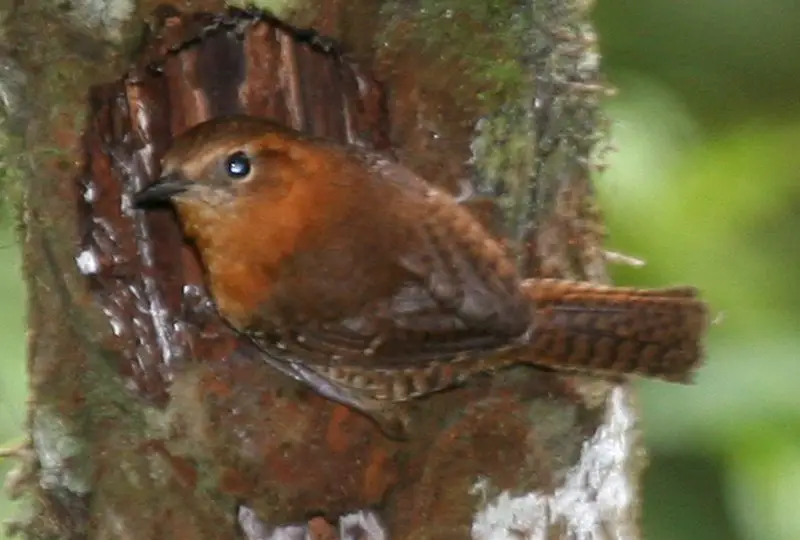
The Rufous-browed Wren is a species of bird in the family Troglodytidae, found throughout Central America from Mexico south into Nicaragua.
It has been considered by some to be part of the Mountain Wren species, but recent genetic analysis shows that it is its own distinct species.
This small wren stands out with its rusty brown crown and back feathers as well as bright white eye stripe and blackish bill.
The four subspecies have slight differences in plumage coloration and size; however they all share similar habitats including evergreen forests, woodlands, shrubbery and gardens.
These birds prefer to forage on or near ground level among leaf litter searching for insects like beetles ants caterpillars spiders etc., which make up their diet alongside seeds berries fruits etc during winter months when food can be scarce.Scientific classification:
| Kingdom | Animalia |
| Phylum | Chordata |
| Class | Aves |
| Order | Passeriformes |
| Family | Troglodytidae |
| Genus | Troglodytes |
| Species | T. rufociliatus |
37. Tepui Wren
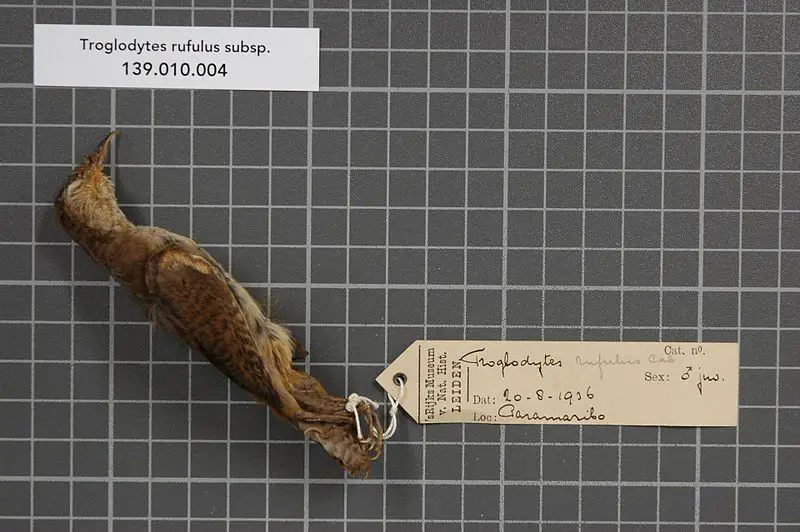
The Tepui wren is a species of bird belonging to the family Troglodytidae. It is natively found in Brazil, Guyana and Venezuela, living on high tablelands called tepuis.
This distinctive looking bird has often been treated as a subspecies of mountain wrens (Troglodytes solstitialis).
Although similar in appearance between these two types of birds, they are actually distinct from one another according to the American Ornithological Society’s South American Classification Committee (SACC/AOS).
The Tepui Wren boasts an impressive plumage with dark brown upper parts that contrast against its white underparts.
Its short tail and rounded wings allow it to fly quickly through dense vegetation while searching for food such as small insects and spiders.
These adaptable creatures can also be found near human dwellings where there are more sources of food available than their natural habitats provide them with.Scientific classification:
| Kingdom | Animalia |
| Phylum | Chordata |
| Class | Aves |
| Order | Passeriformes |
| Family | Troglodytidae |
| Genus | Troglodytes |
| Species | T. rufulus |
38. White-Headed Wren
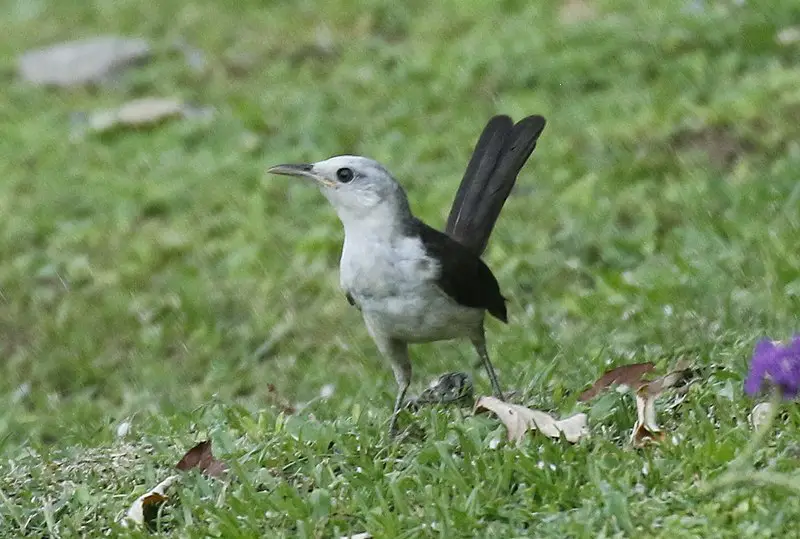
The white-headed wren is a species of bird found mainly in Colombia and Panama. It has been differentiated from the band-backed wren and thrush-like wren due to molecular analyses that confirmed it as a separate species.
This small, greyish brown bird with black stripes on its wings features a distinctive white head that gives it its name.
The diet of this omnivorous creature consists of insects, fruits, flowers and nectar which they look for amongst foliage near or along riversides or humid forests.
They are territorial birds but often form flocks during their migrations between April – May and September – October when travelling southward towards Central America for wintering grounds.Scientific classification:
| Kingdom | Animalia |
| Phylum | Chordata |
| Class | Aves |
| Order | Passeriformes |
| Family | Troglodytidae |
| Genus | Campylorhynchus |
| Species | C. albobrunneus |
39. Thrush-Like Wren
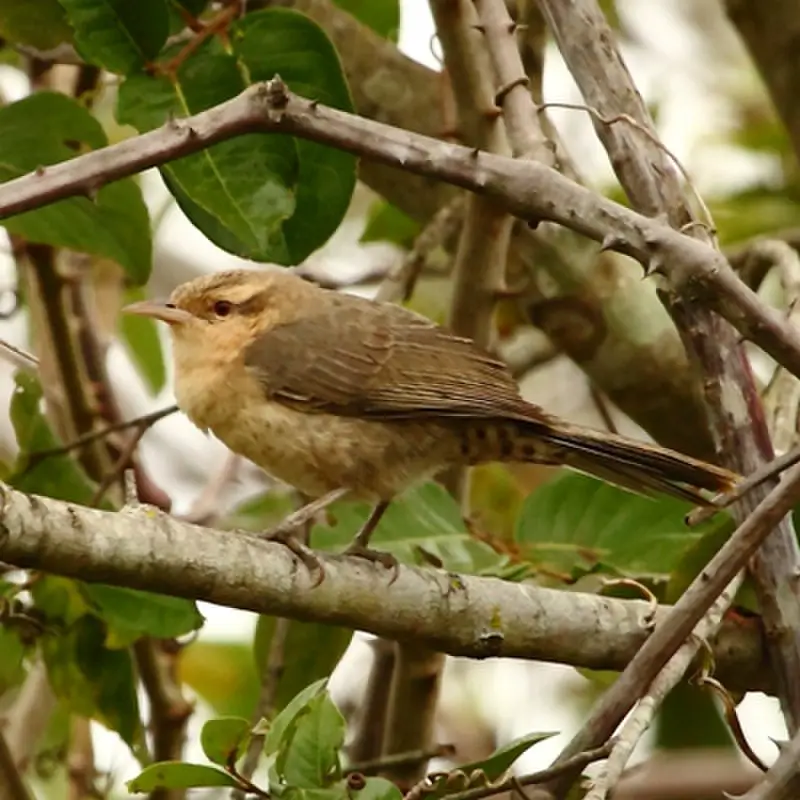
The Thrush-like Wren is a species of bird found in South America. It belongs to the family Troglodytidae and has similar size, colouration and markings as that of a thrush but it can be easily distinguished due to its unique appearance.
The total length of this bird measures about 20 cm (8 inches). This wren is known for its secretive behavior and prefers living near dense vegetation or thickets where they roost during night time.
They are omnivorous birds feeding on insects, fruits, berries & seeds.
During breeding season males attract females using their loud vocalizations like whistles & trills which differentiates them from other members of their family.Scientific classification:
| Kingdom | Animalia |
| Phylum | Chordata |
| Class | Aves |
| Order | Passeriformes |
| Family | Troglodytidae |
| Genus | Campylorhynchus |
| Species | C. turdinus |
40. Santa Marta Wren
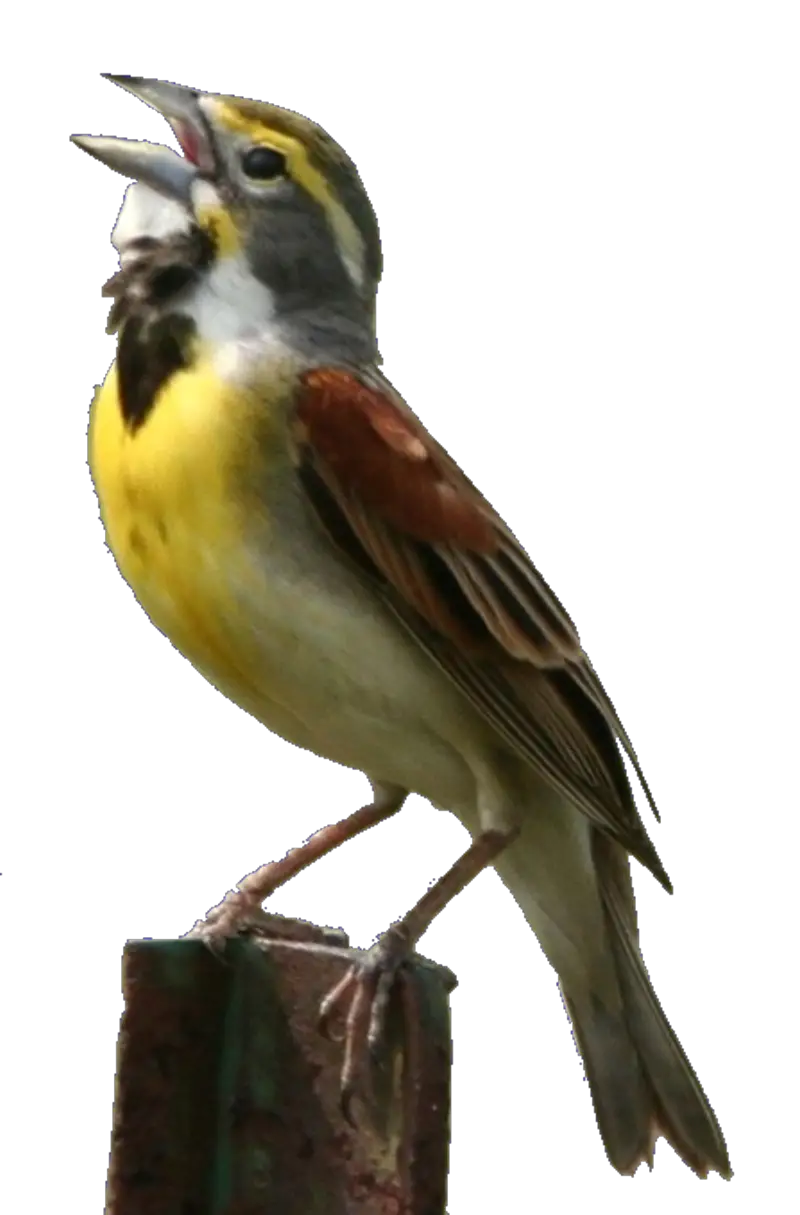
The Santa Marta wren is a species of bird that belongs to the family Troglodytidae. It can be found in Colombia and has been considered as subspecies of mountain wren by some experts.
This small-sized bird features brown upperparts, greyish underparts and white throat with slight rufous pattern on its face.
Its habitat includes dry forest, scrublands and agricultural lands located at altitudes between 1000–2700 m above sea level.
The diet of this species consists mainly insects such as beetles, ants or grasshoppers which it hunts from low shrubs or trees while moving around rapidly like most other members of their family do.
Unfortunately this species is threatened due to deforestation caused by human activities in addition to illegal trapping for pet trade industry hence making them vulnerable according to IUCN red list category criteria evaluation resultsScientific classification:
| Kingdom | Animalia |
| Phylum | Chordata |
| Class | Aves |
| Order | Passeriformes |
| Family | Troglodytidae |
| Genus | Troglodytes |
| Species | T. monticola |
41. Apolinar’s Wren
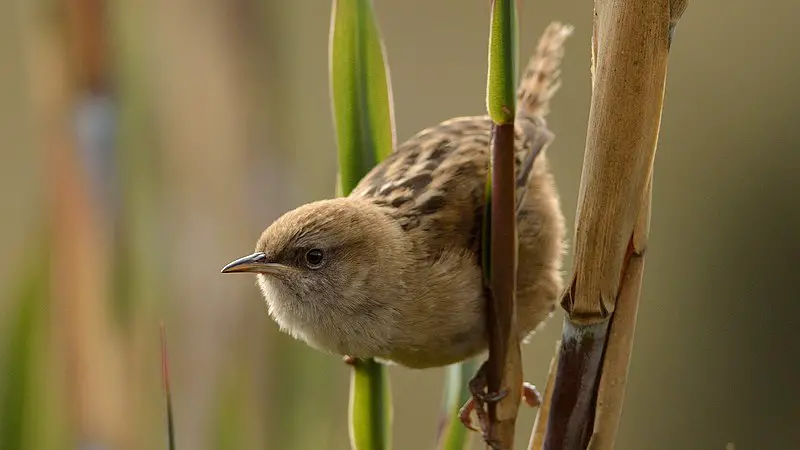
Apolinar’s wren is a small passerine bird belonging to the family Troglodytidae. Endemic to Colombia, it has two subspecies: Cistothorus apolinari apolinari and C.a hernandezi.
The latter was recently described in 2002 and may even be considered its own species due to certain morphological differences from the former one.
Additionally, Apolinar’s wren shares many similarities with grass wren (Cistothorus platensis) and Mérida Wren (Cisthorus meridae), forming an superspecies complex between them all.
It is a delightful little creature that could easily brighten up your garden as you watch it flitting around happily amongst the plants.Scientific classification:
| Kingdom | Animalia |
| Phylum | Chordata |
| Class | Aves |
| Order | Passeriformes |
| Family | Troglodytidae |
| Genus | Cistothorus |
| Species | C. apolinari |
42. Yucatan Wren
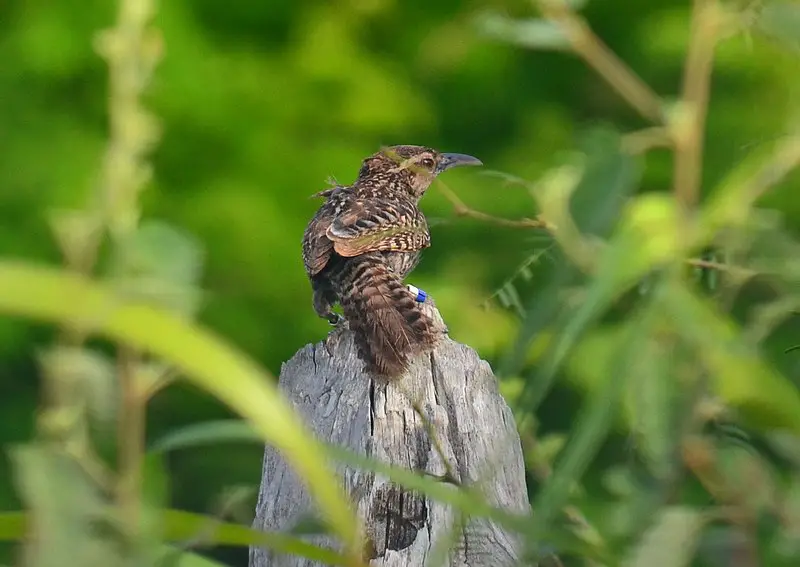
The Yucatan Wren is a small species of bird found only in the narrow coastal strip of northern Yucatán Peninsula, Mexico. It inhabits subtropical or tropical dry shrubland and Petenes mangroves ecoregion.
This bird has greyish brown upperparts with reddish-brown wings and tail tip; its breast is pale buff streaked black above white belly.
Sadly, this beautiful wren is threatened by habitat destruction due to deforestation for agricultural activities as well as human development.
Conservation efforts are therefore needed to protect it from further decline in population numbers and ensure its survival for future generations to enjoy.Scientific classification:
| Kingdom | Animalia |
| Phylum | Chordata |
| Class | Aves |
| Order | Passeriformes |
| Family | Troglodytidae |
| Genus | Campylorhynchus |
| Species | C. yucatanicus |
43. Flutist Wren
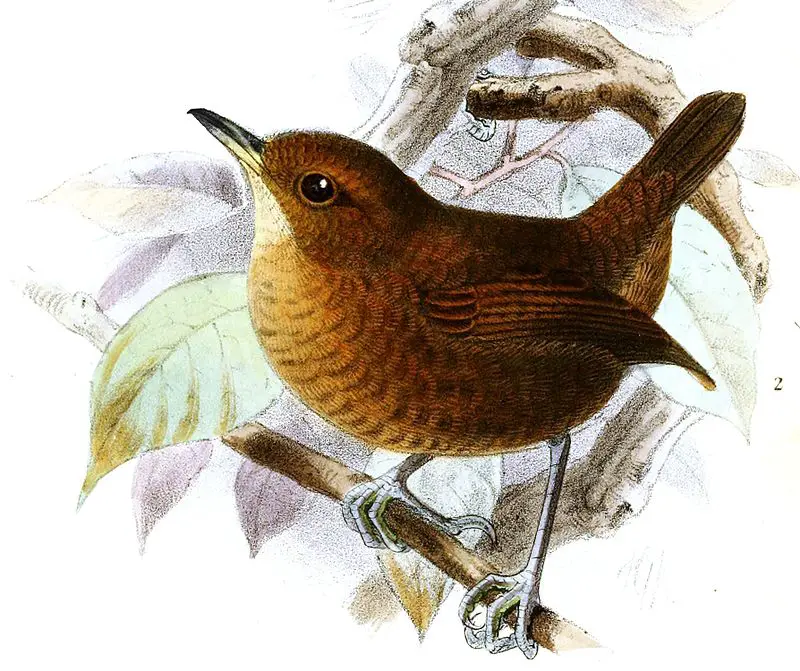
The Flutist Wren is a species of bird found in the humid highland forests of northern Brazil, Guyana, and Venezuela.
It has four subspecies – M. ustulatus ustulatus, duidae, lunatipectus and obscurus – all measuring around 11.5 cm long with males having reddish brown feathers on their upper parts while females are greyer in colouration.
This small bird is known for its melodious fluting call which can often be heard echoing through the forest canopy at dawn or dusk during breeding season from October to March each year when they form monogamous pairs that build a domed nest out of grasses and moss near the trunks of trees where two-five eggs are laid per clutch incubated by both parents who also share responsibility for feeding their young until fledging takes place after about three weeks time.Scientific classification:
| Kingdom | Animalia |
| Phylum | Chordata |
| Class | Aves |
| Order | Passeriformes |
| Family | Troglodytidae |
| Genus | Microcerculus |
| Species | M. ustulatus |
44. Socorro Wren
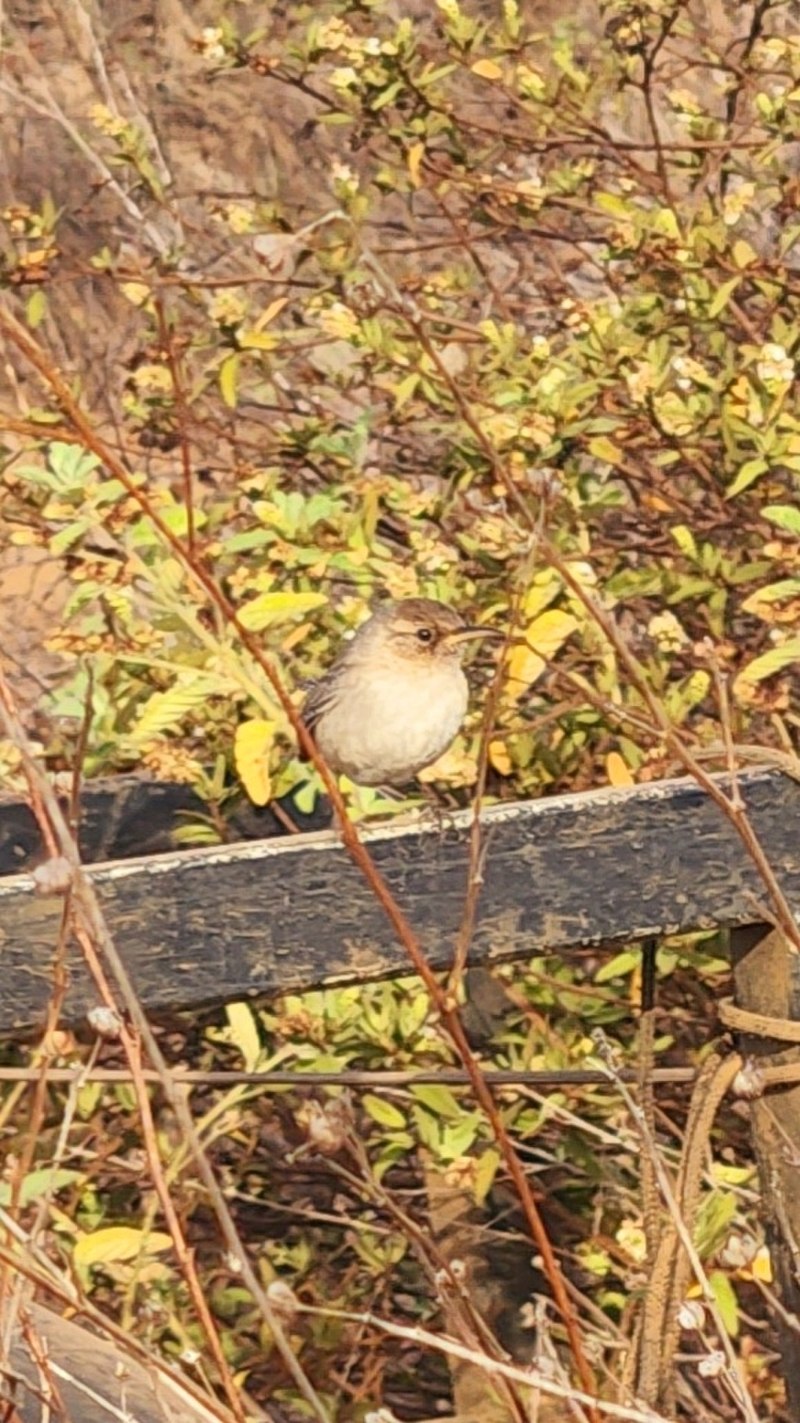
The Socorro wren is a species of bird endemic to the Mexican island of Socorro. It belongs to the family Troglodytidae and was formerly placed in Thryomanes, but it has since been moved due to its mannerisms, song, plumage and other characteristics.
Its natural habitat is tropical arid Croton vegetation.
The species can be identified by its light brown upperparts and white underparts with dark streaks on both sides of their body; they also have a black stripe running from the eyes down the back of their neck.
This unique Wren varies in size between 11-12 cm long making them one of Mexico’s smallest birds.
They form monogamous pairs during breeding season which typically takes place March through August each year when food sources are more abundant.Scientific classification:
| Kingdom | Animalia |
| Phylum | Chordata |
| Class | Aves |
| Order | Passeriformes |
| Family | Troglodytidae |
| Genus | Troglodytes |
| Species | T. sissonii |
45. Tooth-Billed Wren
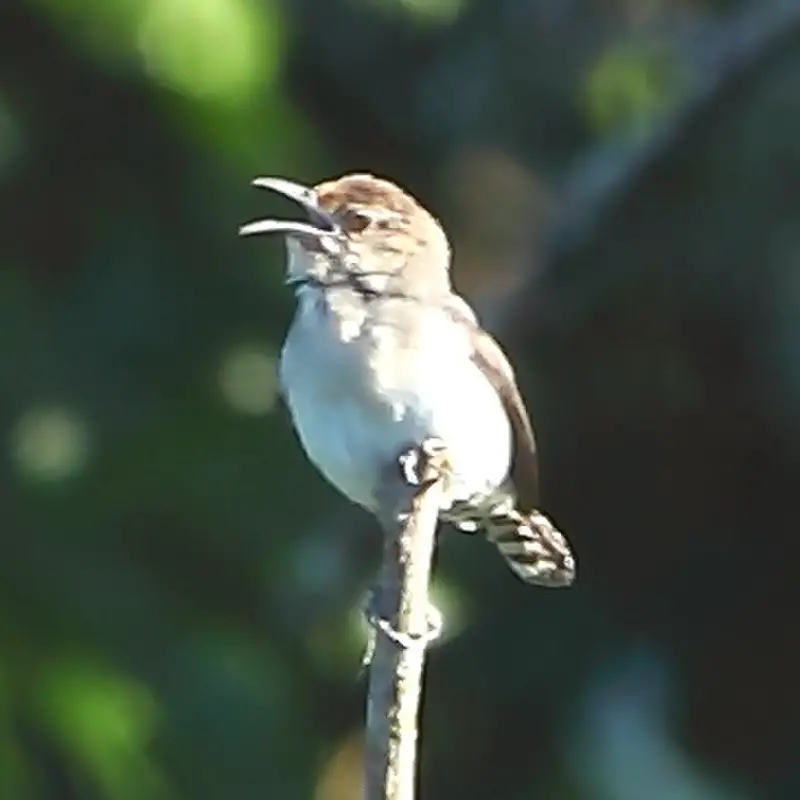
The Tooth-billed Wren is a species of bird in the family Troglodytidae, found in Bolivia and Brazil. It shares its genus with one other species, the Grey-mantled Wren.
These two birds are so closely related that some scientists suggest they should be considered as part of a single superspecies or even just one species.
The Tooth-billed Wren has no subspecies and is unique from all other wrens due to its distinct tooth bill structure.
This little bird typically measures around 10 cm (4 inches) long and weighs about 7 g (0.25 ounces).
Its plumage can vary slightly depending on location but generally it will boast greyish brown feathers above while sporting a white belly below with dark streaks running down each side of its chest region for added flair.Scientific classification:
| Kingdom | Animalia |
| Phylum | Chordata |
| Class | Aves |
| Order | Passeriformes |
| Family | Troglodytidae |
| Genus | Odontorchilus |
| Species | O. cinereus |
46. Variegated Fairywren
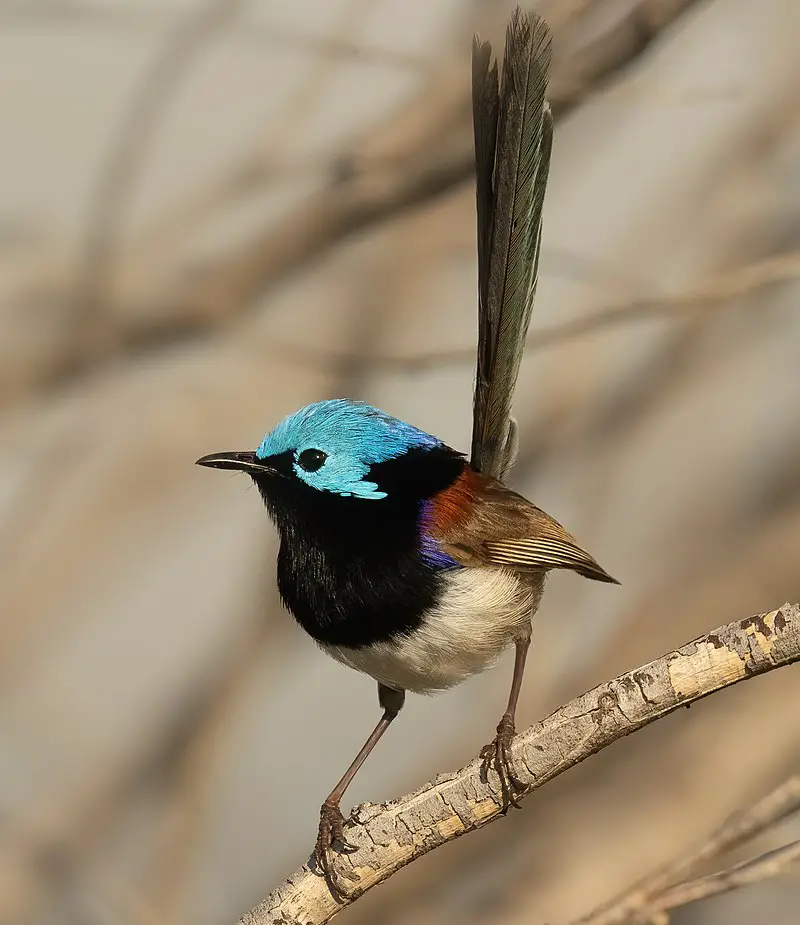
The Variegated Fairywren is a beautiful bird native to eastern Australia. It has distinctive sexual dimorphism, with males being brightly coloured during breeding season while non-breeding males, females and juveniles have grey-brown plumage.
Females of two subspecies are mostly blue-grey in colouration. They inhabit shrubs and bushes near streams or other water sources for their food which predominantly consists of invertebrates such as insects and worms.
These birds also feed on seeds from grasses, sedges and herbs when available in the area they live in.
The nests of these fairywrens are usually built close to ground level within dense vegetation where they can be safe from predators like snakes or cats that could potentially harm them or even snatch away its eggs before hatching occurs.Scientific classification:
| Kingdom | Animalia |
| Phylum | Chordata |
| Class | Aves |
| Order | Passeriformes |
| Family | Maluridae |
| Genus | Malurus |
| Species | M. lamberti |
Also Featured In: Birds that Live in Sunshine Coast, Birds that Live in Gold Coasts
47. Mérida Wren
The Mérida wren is an endemic bird species found in Venezuela. It measures 10 cm (3.9 in) long, and has a medium brown crown with darker streaks on its nape as well as blackish-brown shoulders and undertail coverts.
This species is monotypic and forms part of a superspecies alongside Apolinar’s wren and grass wren.
The Mérida Wren feeds mainly on insects that it finds among the shrubs of its habitat while flying from one bush to another searching for food or shelter when disturbed by predators such as raptors or cats.
Breeding season begins between April–July where both parents are responsible for incubating eggs which hatch after 15 days into five chicks at most per nestling period.
These birds have adapted to live amongst humans making them vulnerable to predation through human activities like pet trade so conservation efforts must be taken seriously if we want our future generations to keep enjoying their beauty within nature’s canopy.Scientific classification:
| Kingdom | Animalia |
| Phylum | Chordata |
| Class | Aves |
| Order | Passeriformes |
| Family | Troglodytidae |
| Genus | Cistothorus |
| Species | C. meridae |
48. Sumichrast’s Wren
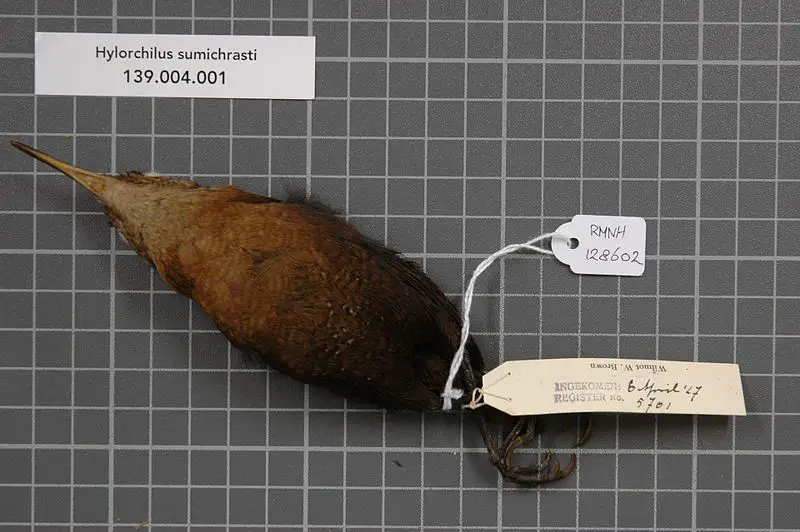
Sumichrast’s wren is a species of bird found only in Mexico, belonging to the family Troglodytidae. It has been given its common name after Mexican naturalist François Sumichrast who discovered it.
The slender-billed wren stands out for its monotypic nature and was previously considered as a subspecies by the name Hylorchilus sumichrasti navai before being upgraded to species status known as Nava’s Wren during 1990s.
This small brownish grey colored bird with long wings lives mainly on insects and seeds that it finds while hopping among branches of trees or shrubs usually located near water bodies like rivers or streams.Scientific classification:
| Kingdom | Animalia |
| Phylum | Chordata |
| Class | Aves |
| Order | Passeriformes |
| Family | Troglodytidae |
| Genus | Hylorchilus |
| Species | H. sumichrasti |
49. Grey-Mantled Wren
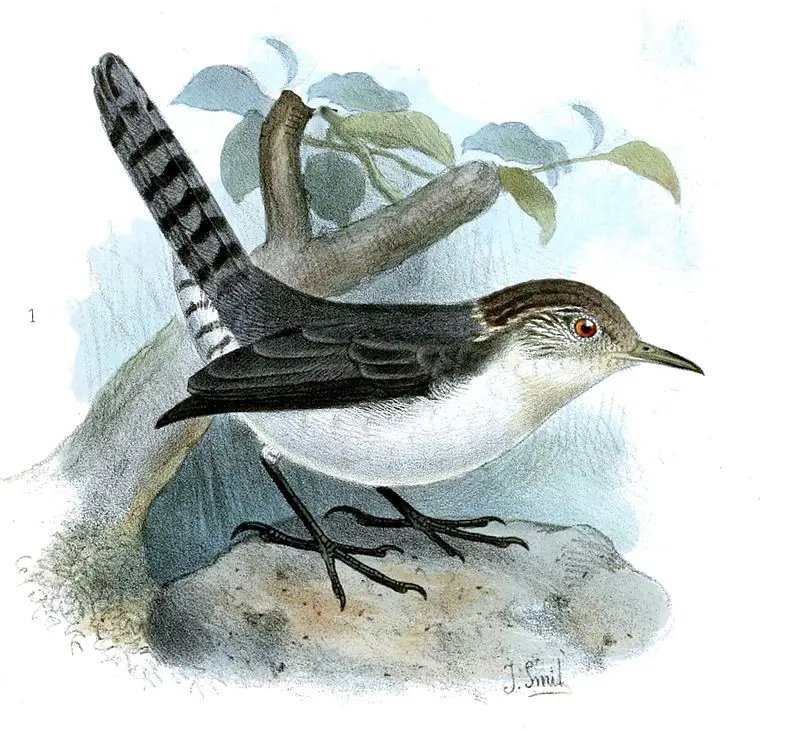
The Grey-mantled Wren (Odontorchilus branickii) is a species of bird in the family Troglodytidae native to Bolivia, Colombia, Ecuador and Peru. This small songbird has two subspecies – O.
b. hellmayri from western Peru and O. b .branickii from eastern parts of its range as well as northern Bolivia and south-western Colombia.
It is closely related to the Tooth-billed Wren which some authors suggest they may be one species or part of a superspecies complex due to their similarities but this is still unconfirmed by research.
The plumage on this wren varies between greyish brown with white below for males while females have an overall duller look than males but are otherwise similar in appearance apart from size difference.
They prefer dense undergrowth near water where they can find plenty insects such as beetles, flies and caterpillars that make up most of their diet along with some fruit when available during certain times of year.Scientific classification:
| Kingdom | Animalia |
| Phylum | Chordata |
| Class | Aves |
| Order | Passeriformes |
| Family | Troglodytidae |
| Genus | Odontorchilus |
| Species | O. branickii |
50. White-Breasted Wood Wren
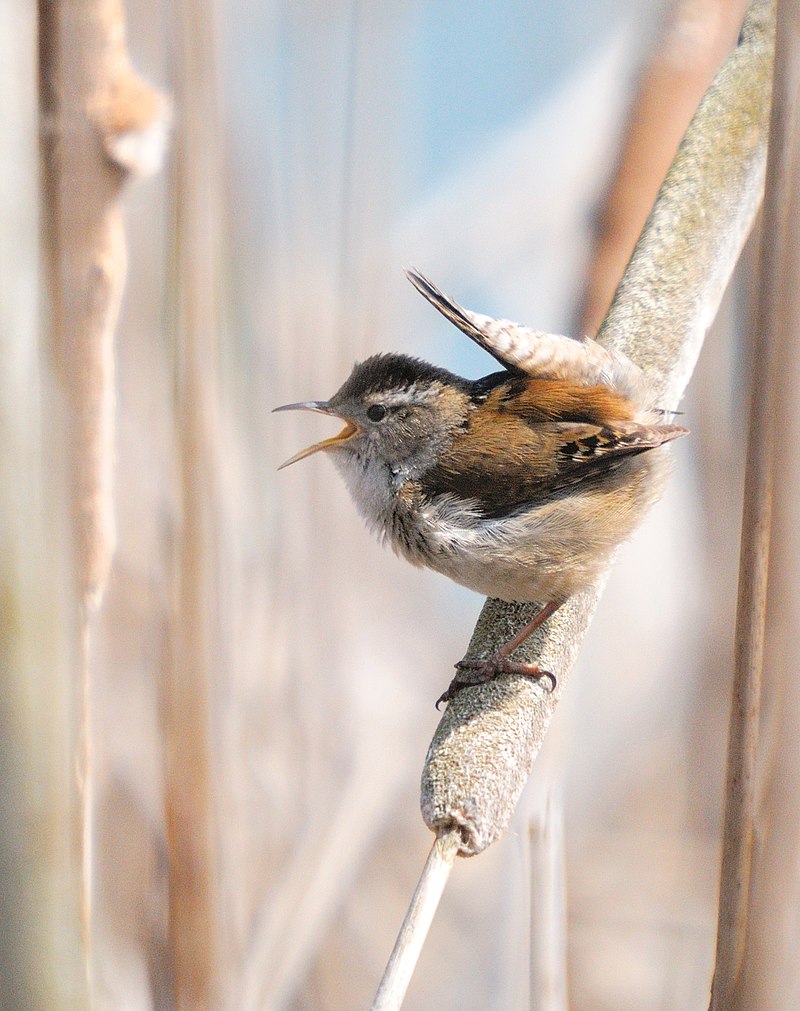
Wrens are a family of small brown passerine birds found mainly in the Americas. They are considered one of the most abundant bird species, with 88 known varieties divided into 19 genera.
The Eurasian wren is the only type that inhabits Europe and other parts of the Old World, where it’s commonly referred to simply as “wren.”
This species has been given its name due to similar-looking unrelated birds living elsewhere such as New Zealand wrasses.
Wrens have tiny bodies with thin bills and long tails which they often hold upright for hours at a time while singing their loud cheery songs from treetops or low shrubs.
Their diet consists mostly of insects but can also include fruits and seeds depending on availability in their habitat range.Scientific classification:
| Kingdom | Animalia |
| Phylum | Chordata |
| Class | Aves |
| Order | Passeriformes |
| Superfamily | Certhioidea |
| Family | Troglodytidae Swainson, 1832 |
51. Grey-Breasted Wood Wren
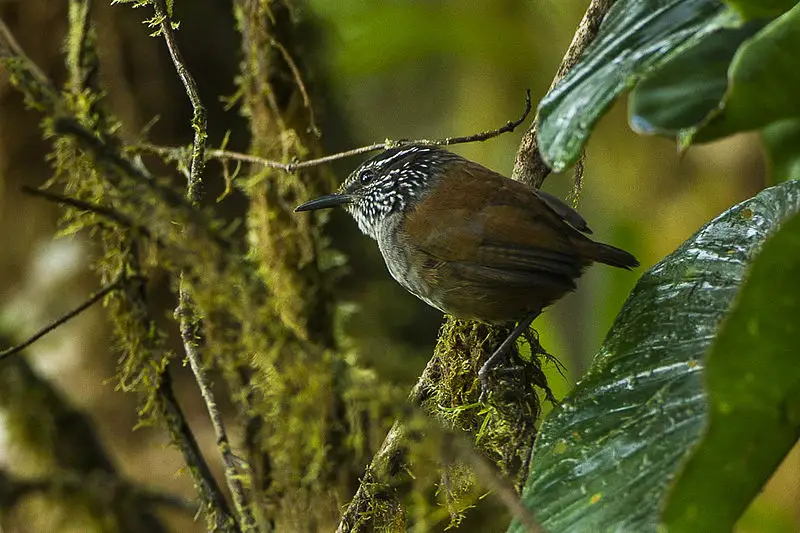
The grey-breasted wood wren is a species of bird found in Central and South America, ranging from Mexico to Bolivia.
It belongs to the family Troglodytidae and its taxonomy at the subspecies level remains uncertain as it may have 17 or 13 subspecies according to different organizations.
It has an overall grayish brown body with white spots on its wings and tail feathers, while adult males also possess a bright reddish crown that distinguish them from females.
Its diet mainly consists of insects such as moths, beetles and spiders which it forages for among trees or shrubs near streams or moist forests during daytime hours.
The Grey-breasted Wood Wren usually forms pairs when breeding season starts; they build their nests using twigs inside bushes or thick vegetation close by water sources where both parents incubate two eggs until they hatch after 14 days before raising their young ones together until independent enough to leave the nest.Scientific classification:
| Kingdom | Animalia |
| Phylum | Chordata |
| Class | Aves |
| Order | Passeriformes |
| Family | Troglodytidae |
| Genus | Henicorhina |
| Species | H. leucophrys |